Experimental Behavior of a Full-Scale Housing Section Built with Cold-Formed Steel Shear Wall Panels under Horizontal Monotonic and Cyclic Loading
Abstract
:1. Introduction
2. Full-Scale Specimen Section Test
2.1. Wall Panel Set Configuration
- As low-cost alternative buildings, the walls were made on a unique external fibrocement panel, which presented 14 mm of thickness, as recommended by the manufacturer. A purpose was made: a model formed only with three walls; one that would receive the load on it and two other perpendicular walls on the extremes, all side by side with a CFS system ceiling;
- The critical requesting on the walls were applied perpendicularly to the bigger plan (6.10 m long) that was defined as the worst architectonic alternative or situation presented to the designed housing;
- On the process of determination of the specimen dimensions some aspects were taken into account: building system and housing changes, the infrastructure and equipment limits of the “Laboratorio de Estructuras Grandes” (Big Structures Laboratory) and economic limits.
- Wall 1: 6.10 m long and 2.44 m high wall, built with five panels, 1.22 m × 2.44 m and 14 mm thick, with 11 vertical support profiles PE (section: 98.4 mm × 50 mm and 0.80 mm thick) every 0.61 m, two profiles PA (cross section dimensions 100 mm × 50 mm and 0.80 mm thick) an upper profile and a lower one, oriented to the north–south direction. (Shown on Figure 1);
- Wall 2: 1.22 m long and 2.44 m high wall, built on a panel which incorporates three vertical support profiles PE of 0.61 m each, two profiles PA, an upper profile and a lower one, fixed to Wall 1 on the north extreme. (Shown on Figure 6);
- Wall 3: 1.22 m long and 2.44 m high wall, built on a panel which has three vertical support profiles PE of 0.61 m each, two profiles PA an upper one and a lower one, fixed to Wall 1 on the south extreme. (Shown on Figure 6);
- Celling: 6.10 m long and 1.22 m large Ceiling, built with two-and-a-half sheets, with six horizontal support profiles PE of 1.22 m each, fixed to the formed by wall 1, 2 and 3 (shown on Figure 4 and Figure 5). On the free side of the ceiling, which would be 6.10 m long, it was necessary to put two intermediate supports for avoiding an excessive flexion on it.
- The wind load was applied as a uniform load of 38.4 kg/m2 to the shell items of the frontal wall. Knowing that the total surface of these items is 2.44 m × 6.10 m, the total load applied should be 570 kg.
- Screws for the attachment of the sheet on the steel framework. #8 × ½” extra flat anti-slip head, S-type tread, self-drilling drill point, LH 8-050;
- Screws for the attachment of the sheet on the steel framework. #8 × 1¼” bugle head, with self-countersinking, S12-type thread, self-drilling drill point PH 8-125;
- Foundation anchor screws, of 3/8” Diameter.
2.2. Seismic and Wind Critical Loads
2.2.1. Seismic Critical Load
2.2.2. Wind Critical Loads
2.2.3. Critical Load
2.3. Materials Tests
2.3.1. Cold-Formed Steel Profiles
2.3.2. Fibrocement Panels
3. Experiment Details
3.1. Instrumentation Test Setup
3.1.1. Location of Displacement and Control Transducers (CDP)
3.1.2. Strain Gauges Location
3.2. Wall Panel Set Loading Protocols
3.3. Full-Scale Specimen Section Set Results
3.3.1. Record of Displacements and Loads
3.3.2. Failure Modes in Monotonic and Cyclic Loading Tests
- From start to the load cycle 6, no damage was observed at all on the model;
- At the end of the load cycle 7, a rotation on the vertical profiles and a sprain of the anchor profile was observed on the wall 1 base (shown on Figure 16a). A short separation between the intermediate vertical steel sheet profiles and the fibrocement sheets were also detected (shown on Figure 16b);
- At the end of the load cycle 12, torsional buckling of the higher anchor profile PA of wall 1 could be appreciated, more evident on the central section (Figure 16c).
- 4.
- At the end of the load cycle 18, in front of slightly high to the 1000 kg load, an elevation of 6.0 mm or less was evident uniformly on the length of the wall 1. The walls 2 and 3 presented variable elevations, near to the 6.0 mm on the extremes that joined to the wall 1, and simultaneously they reduced on the other extremes. This deformation pattern was incremental. At the end of the load cycle 22, because of the use of a nearly 1500 kg load, an elevation of 8.0 mm on the wall 1 was registered (see Figure 17).
- 5.
- At the end of the load cycle 19, a fissure was generated on one of the fibrocement sheets on the east face of wall 1, identified as Crack G1, that will spread and widen to later stages (shown on Figure 18). This fissure appeared close to one of the neoprene pads of the hydraulic jacks and to the vertical sheet profile.
- 6.
- The ceiling structure flexed itself to the top, on a way that makes it lose contact with the other two vertical posterior supports given (as shown on Figure 19). Separations start to appear between the steel and the fibrocement sheets on the intersections of wall 1 with the transversal walls, that were rising on later load cycles (shown on Figure 20);
- 7.
- At the end of the load cycle 20, a failure is presented in another fibrocement sheet of the east face of wall 1, identified as crack G2, that will expand and spread on the following cycles (Figure 20). This crack appears also next to one of the neoprene pads of the hydraulic jacks, but there was not a vertical steel profile next to it as happened with crack G1;
- 8.
- At the end of the load cycle 21, due to a load of nearly 1600 kg, crack G3 and G4 appeared on the west face of wall 1. Both cracks correspond to crack G1 and G2, respectively;
- 9.
- At the end on the load cycle 22, the rotation of wall 1 compared to the base is clear and produces horizontal displacements of the ceiling structure of about 60 mm. Walls 2 and 3 deform themselves to adapt themselves to the spin. The vertical displacement of the ceiling on the pillars is nearly 20 mm;
- 10.
- At the end on the load cycle 23, the collapse of the fibrocement sheet happens, on the place that G2 and G4 had appear (shown on Figure 21);
- 11.
- As a consequence of the crash of the sheet, the adjacent contact profiles PE suffered a permanent deformation, and the anchor profile PA of the base suffered a considerable separation to its base.
3.3.3. Relationship between the Load–Displacement Obtained
4. Finite Elements Model Details
- Steel profiles were modelled as frame elements. Nominal values were used on the cold-formed steel to define its properties: elasticity unit (Es = 2.074 × 106 kg/cm2), yield strength (Fy = 2310 kg/cm2), Poisson’s ratio (µ = 0.30), volumetric weight (γs= 7.849 kg/cm3) being the physical properties of each profile; PA (d = 10.00 cm, b = 3.20 cm, t = 0.80 cm), PE (d = 9.84 cm, b = 5.00 cm, t = 0.80 cm);
- Fibrocement sheets were modelled as shell elements, combining the plate and membrane behavior. Nominal values given by the manufacturer were used: elasticity unit (Efc = 33,130 kg/cm2), Poisson´s ratio (µ = 0.20), volumetric weight (γfc = 1.100 kg/cm3), being the properties of this section: the thickness for the plate behavior (tpl = 1.40 cm), and the thickness for the membrane behavior (tm = 1.40 cm);
- Connections between the steel sheets were considered as pinned connection and they were only retrained to displacements and not to rotations;
- Screwed connections between profiles and panels were modelled as rigid links, to the profile´s centroidal axis to the sheet´s centroidal axis. When there was not relative displacements or deformations in this connection, the links had the goal of applying similar actions as the interface of the two structural component screws did;
- Wind load was considered and applied on a uniform load of 38.4 kg/m2 to the shell items of the frontal wall.
- The higher experimented deformation shown by the system was on the center of the frontal wall, on its upper extreme, resulting to be 0.897 cm;
- The stiffness of the system, defined in this particular case as a total applied load (571.55 kg) and the higher experimented deformation by the system being 637 kg/cm;
- The profiles PE rotate from the base and deform on the same way as the steel beam. Figure 24b shows the deformation scaled from the central profile PE.
- The upper profile PA suffers nearly the same displacements on the length of it, and its deformations, even if they are very little, are similar to the experimented by the standing beam. Figure 24a shows this deformation;
- Figure 24b shows the variation of bending moments on the direction that they apply the load to the profiles PE, that is, the horizontal direction.
5. Discussion, Evaluation and Comparison of the Results of Analytical and Experimental Models
5.1. Resistance Parameters and Criteria
5.2. Stiffness Parameters and Criteria
5.3. Structural Behavior Criteria and Parameters
6. Conclusions
- The panel system with one single lining formed by fibrocement sheets and thin steel sheets is satisfactory for the use as a one floor housing principal structure. The experimental model strength reaches the critical demand imposed by the technical design rules for earthquakes and wind of El Salvador. Unless under special conditions, this typology of structure is safety for the wind and seismic demands;
- The numerical model behavior is very similar to the experimental specimen tested. Therefore, the structural analysis developed by simulation can be used on a reliable way to model different alternatives;
- The resistance levels offered from the manufacturers are enough reliable to use them as structural revision criteria on the alternative design process, since the manufacturing process of the considered material is industrialized;
- The stiffness obtained from the numerical model was higher than the ones obtained on the experimental specimen. For that reason, on the case of structural simulation the deformations obtained can be under-estimated;
- The permanent deformations registered on the experiment are caused by local buckling of the components of the transversal section of the steel profiles and the separations between these profiles and the fibrocement sheets that appear when the loads are raised. The profiles have a post-buckling resistance reservation, where some parts of the profile conserve their full capacity of resistance and the possibility of using this property on structures even if it exists a partial failure on them;
- The deformations appeared on the ceiling are considered excessive due to some of the load values. The revision and the improvement of the structural system should be considered as future steps.
Author Contributions
Funding
Institutional Review Board Statement
Informed Consent Statement
Acknowledgments
Conflicts of Interest
References
- Serrette, R.; Hall, G.; Nguyen, H. Shear Wall Values for Light Weight Steel Framing. Final Report; American Iron Steel Institute: Washington, DC, USA, 1996. [Google Scholar]
- Serrette, R.L.; Encalada, J.; Juadines, M.; Nguyen, H. Static Racking Behavior of Plywood, OSB, Gypsum, and FiberBond Walls with Metal Framing. J. Struct. Eng. 1997, 123, 1079–1086. [Google Scholar] [CrossRef]
- Greem, G.G.; Winter, G.; Cuykendall, T.R. Light Gage Steel Columns in Wall-Braced Panels, Bulletin N°. 35/2; Cornell University: Ithaca, NY, USA, 1947. [Google Scholar]
- Simaan, A. Buckling of Diaphragm-Braced Columns of Unsymmetrical Sections and Application to Wall Studs Design; Cornell University: Ithaca, NY, USA, 1973. [Google Scholar]
- AISI. AISI Manual Cold-Formed Steel Design, 2002nd ed.; AISI: Washington, DC, USA, 2003. [Google Scholar]
- Miller, T.H.; Pekoz, T. Bevaviour of GypsumSheatehed Cold-Formed steel wall studs. Struct. Eng. 1994, 120, 1644–1650. [Google Scholar]
- European Committee for Standardization (CEN). Eurocode CEN 3. Design of Steel Structures Part 1–3, Design of Cold-Formed Steel Structures. BS EN 1993-1-3; European Committee for Standardization (CEN): Brussels, Belgium, 2004. [Google Scholar]
- Serrette, R.; Ogunfunmi, K. Shear Resistance of Gypsum-Sheathed Light-Gauge Steel Stud Walls. J. Struct. Eng. 1996, 122, 383–389. [Google Scholar] [CrossRef]
- Fiorino, L.; Iuorio, O.; Landolfo, R. Sheathed cold-formed steel housing: A seismic design procedure. Thin-Walled Struct. 2009, 47, 919–930. [Google Scholar] [CrossRef]
- Lange, J.; Naujoks, B. Behaviour of cold-formed steel shear walls under horizontal and vertical loads. Thin-Walled Struct. 2006, 44, 1214–1222. [Google Scholar] [CrossRef]
- Pan, C.-L.; Shan, M.-Y. Monotonic shear tests of cold-formed steel wall frames with sheathing. Thin-Walled Struct. 2011, 49, 363–370. [Google Scholar] [CrossRef]
- Fiorino, L.; Della Corte, G.; Landolfo, R. Experimental tests on typical screw connections for cold-formed steel housing. Eng. Struct. 2007, 29, 1761–1773. [Google Scholar] [CrossRef]
- Tian, Y.; Wang, J.; Lu, T. Racking strength and stiffness of cold-formed steel wall frames. J. Constr. Steel Res. 2004, 60, 1069–1093. [Google Scholar] [CrossRef]
- Kim, T.-W.; Wilcoski, J.; Foutch, D.A.; Lee, M.S. Shaketable tests of a cold-formed steel shear panel. Eng. Struct. 2006, 28, 1462–1470. [Google Scholar] [CrossRef]
- Al-Kharat, M.; Rogers, C. Inelastic performance of cold-formed steel strap braced walls. J. Constr. Steel Res. 2007, 63, 460–474. [Google Scholar] [CrossRef]
- Yu, C. Shear resistance of cold-formed steel framed shear walls with 0.686 mm, 0.762 mm, and 0.838 mm steel sheet sheathing. Eng. Struct. 2010, 32, 1522–1529. [Google Scholar] [CrossRef]
- Tian, Y.; Wang, J.; Lu, T. Axial load capacity of cold-formed steel wall stud with sheathing. Thin-Walled Struct. 2007, 45, 537–551. [Google Scholar] [CrossRef]
- Tian, Y.; Wang, J.; Lu, T.; Barlow, C. An experimental study on the axial behaviour of cold-formed steel wall studs and panels. Thin-Walled Struct. 2003, 42, 557–573. [Google Scholar] [CrossRef]
- Vieira, L.; Shifferaw, Y.; Schafer, B. Experiments on sheathed cold-formed steel studs in compression. J. Constr. Steel Res. 2011, 67, 1554–1566. [Google Scholar] [CrossRef]
- Vieira, L.C.; Schafer, B.W. Lateral stiffness and strength of sheathing braced cold-formed steel stud walls. Eng. Struct. 2012, 37, 205–213. [Google Scholar] [CrossRef]
- Baran, E.; Alica, C. Behavior of cold-formed steel wall panels under monotonic horizontal loading. J. Constr. Steel Res. 2012, 79, 1–8. [Google Scholar] [CrossRef]
- Naujoks, B. Tragverhalten von Wandtanfeln mit Kaltprofilen unter Horizontalen Vertikalen Lasten. Ph.D. Thesis, Technische Universität Darmstadt, Darmstadt, Germany, 2002. [Google Scholar]
- Nithyadharan, M.; Kalyanaraman, V. Behaviour of cold-formed steel shear wall panels under monotonic and reversed cyclic loading. Thin-Walled Struct. 2012, 60, 12–23. [Google Scholar] [CrossRef]
- Martínez-Martínez, J.; Xu, L. Simplified nonlinear finite element analysis of buildings with CFS shear wall panels. J. Constr. Steel Res. 2011, 67, 565–575. [Google Scholar] [CrossRef]
- Murtinho, V.; Simoes da Silva, L.; Correira, A.; Ferreira, H.; Rebelo, C.; Santos, P.; Gervasio, H.; Jordao, S.; Santiago, A.; Rigueiro, C.; et al. Casas asequibles, un concepto modular de vivienda unifamiliar residencial. In Proceedings of the VII Congresso de Construção Metálica e Mista, Lisboa, Portugal, 19–20 November 2009; Volume 1, pp. 27–31. [Google Scholar]
- Fiorino, L.; Terracciano, M.T.; Landolfo, R. Experimental investigation of seismic behaviour of low dissipative CFS strap-braced stud walls. J. Constr. Steel Res. 2016, 127, 92–107. [Google Scholar] [CrossRef]
- Landolfo, R.; Fiorino, L.; Della Corte, G. Seismic Behavior of Sheathed Cold-Formed Structures: Physical Tests. J. Struct. Eng. 2006, 132, 570–581. [Google Scholar] [CrossRef]
- Landolfo, R.; Fiorino, L.; Iuorio, O. A Specific Procedure for Seismic Design of Cold-Formed Steel Housing. Adv. Steel Constr. 2010, 6, 603–618. [Google Scholar] [CrossRef]
- Available online: http://viviendasocial.vivienda.gob.sv/www/prov/wf_prov.aspx?idp=3&idh=1 (accessed on 30 June 2021).
- Norma Técnica de Diseño por Sismo de El Salvador (NTDSES). Reglamento de la Seguridad Estructural de las Construcciones. 1997. Available online: https://www.jurisprudencia.gob.sv/DocumentosBoveda/D/2/1990-1999/1996/10/89243.PDF (accessed on 30 June 2021).
- Ministerio de Obras Públicas, República de El Salvador. Norma Técnica de Diseño por Viento. Reglamento de Seguridad Estructural de las Construcciónes; Ministerio de Obras Públicas, República de El Salvador: San Salvador, El Salvador, 1997.
- ASTM International. A01 Committee Test Methods and Definitions for Mechanical Testing of Steel Products; ASTM International: West Conshohocken, PA, USA, 2020. [Google Scholar] [CrossRef]
- ASTM International. ASTM Standard Test Methods of Conducting Strength Tests of Panels for Building Construction; ASTM International: West Conshohocken, PA, USA, 2014; pp. 1–9. [Google Scholar] [CrossRef]
- ASTM International. C17 Committee Specification for Asbestos-Cement Fiberboard Insulating Panels; ASTM International: West Conshohocken, PA, USA, 1900. [Google Scholar] [CrossRef]
- Computers and Structures, Inc. SAP2000 Integrated Software for Structural Analysis & Design; Computers and Structures, Inc.: Berkley, CA, USA, 2016. [Google Scholar]
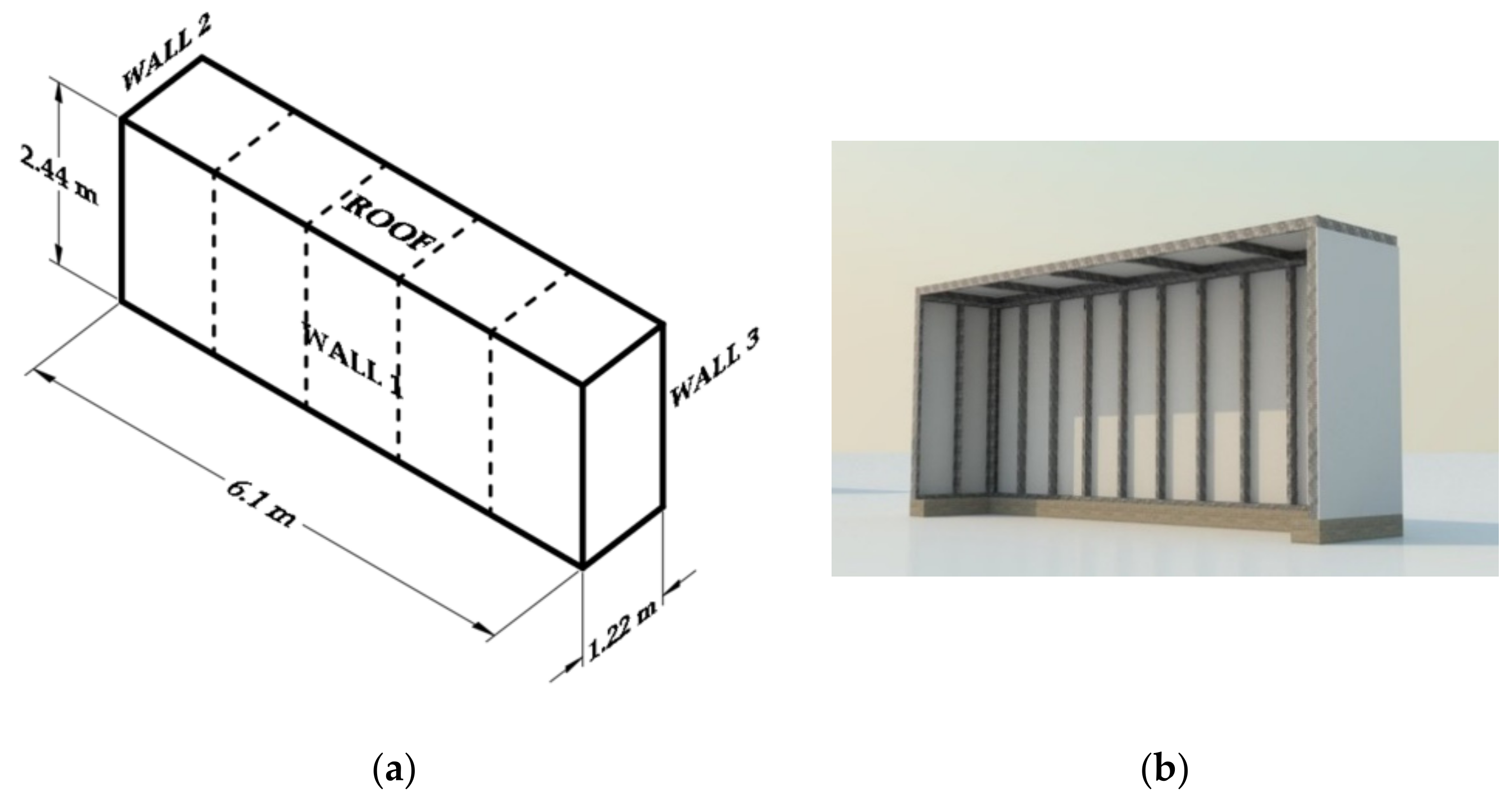
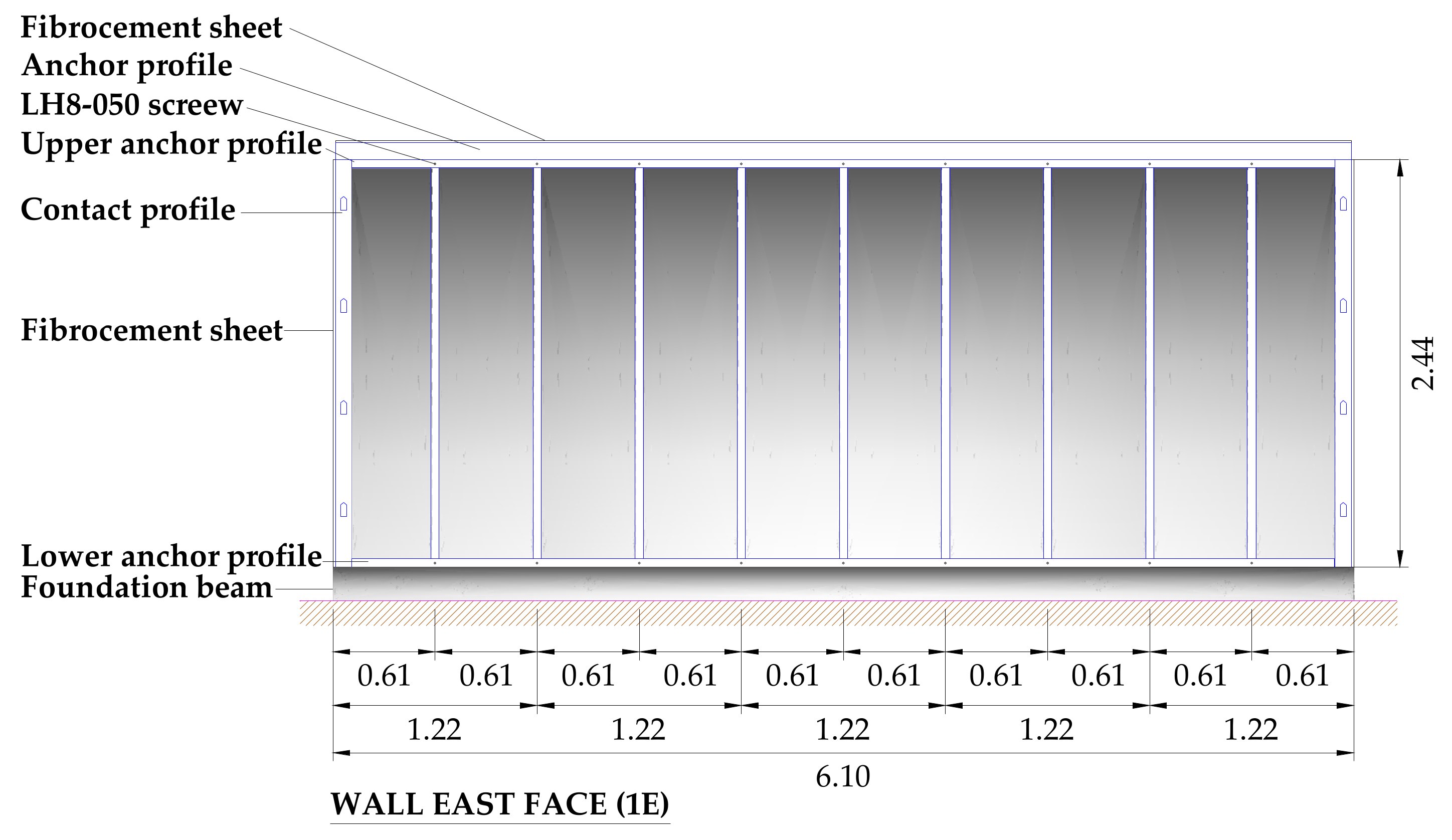

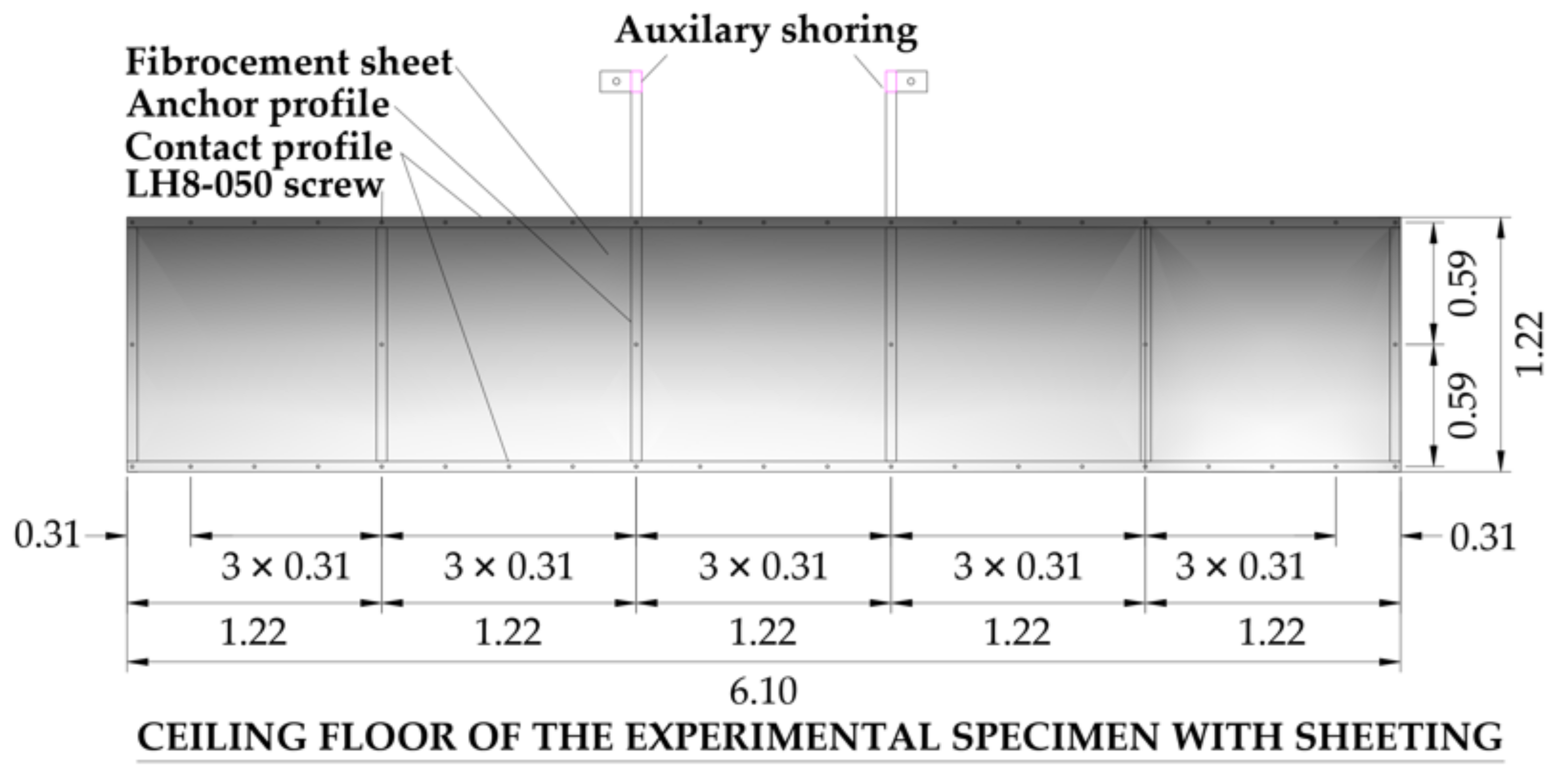
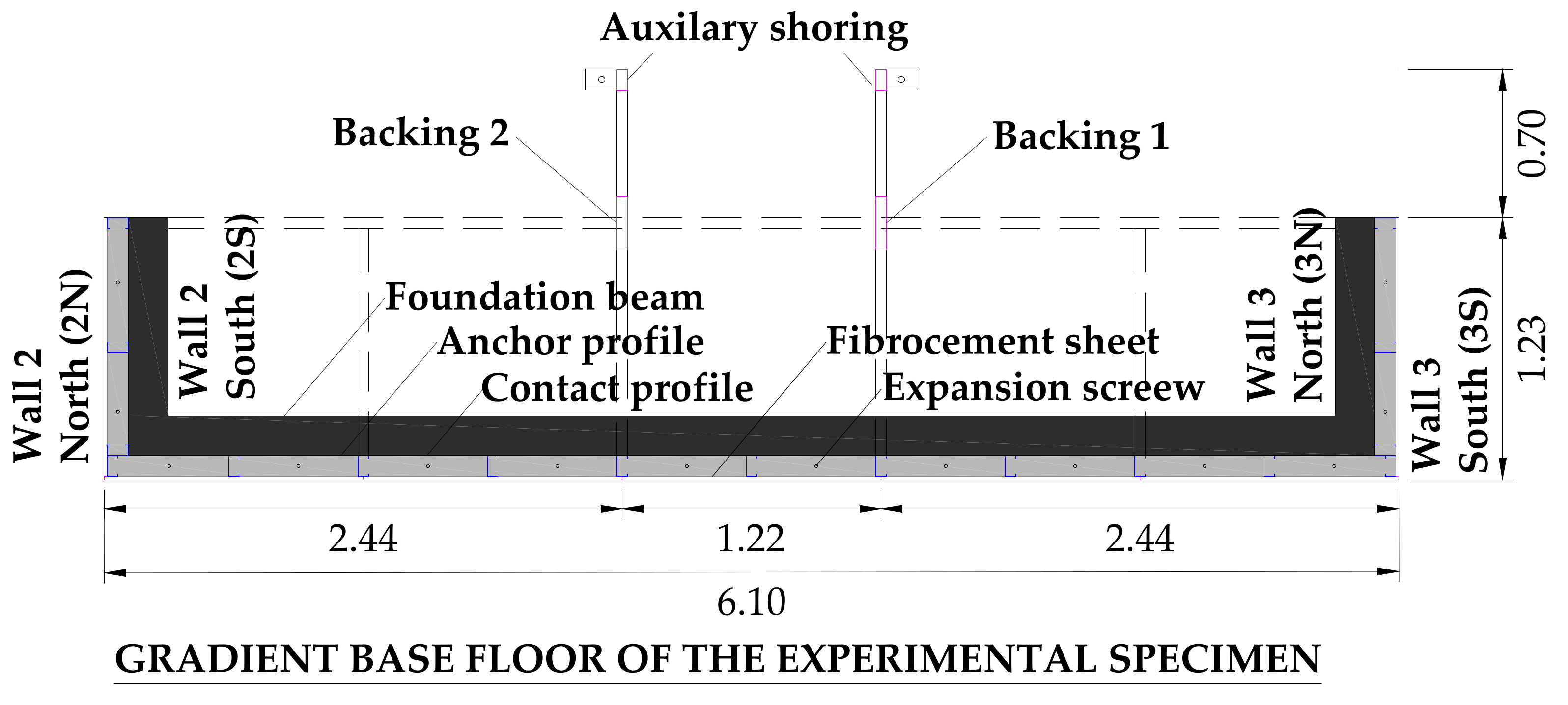

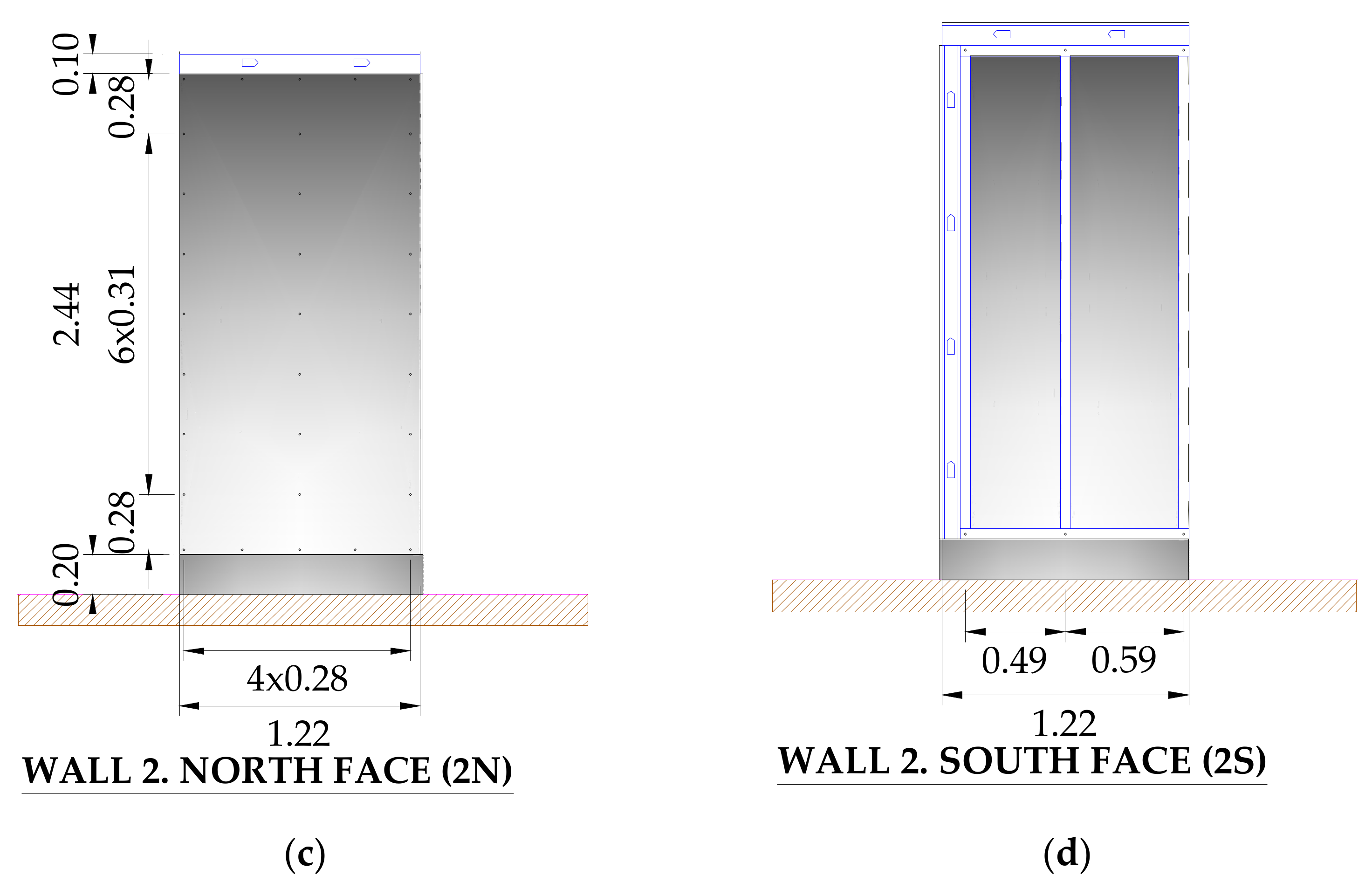
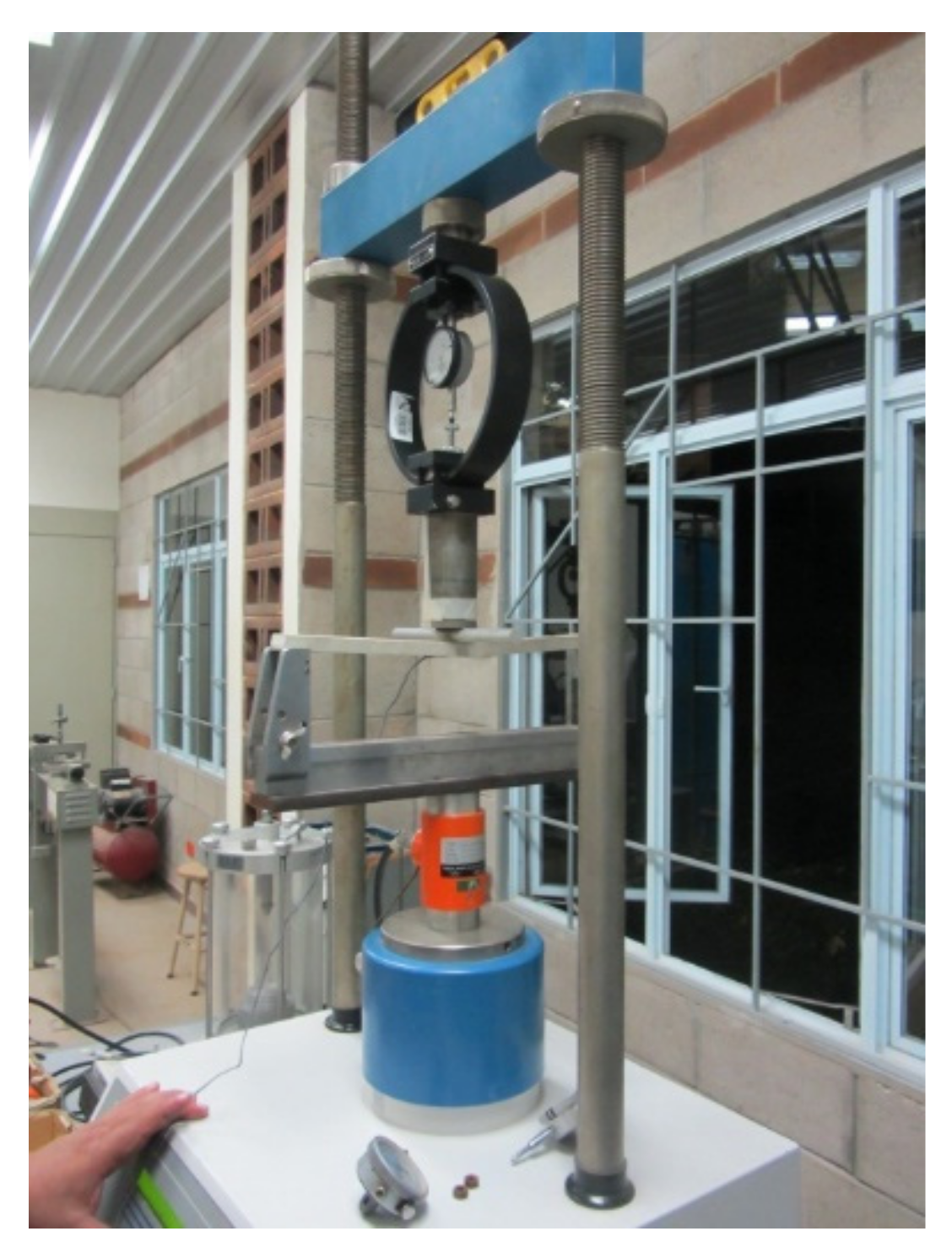
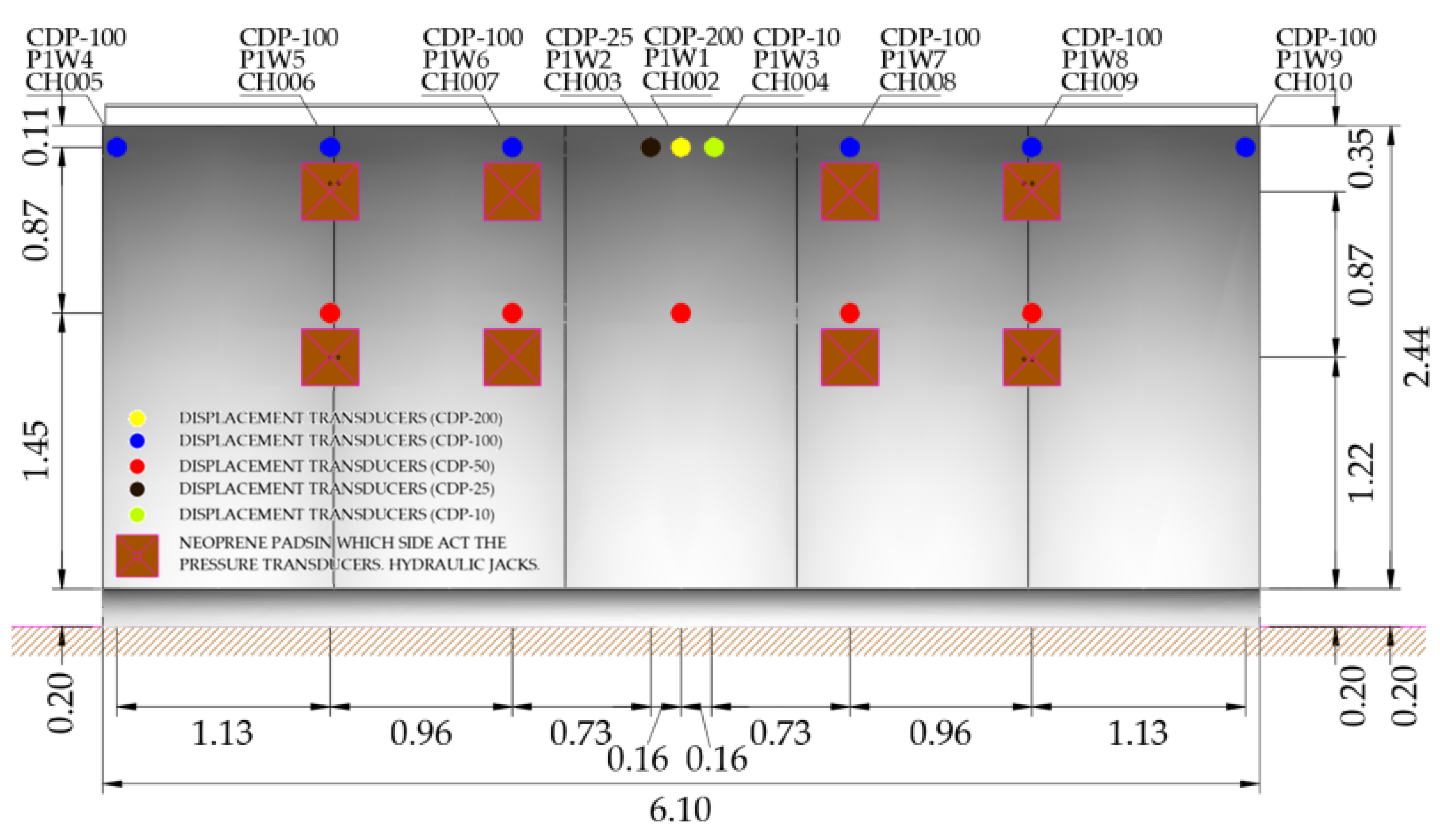
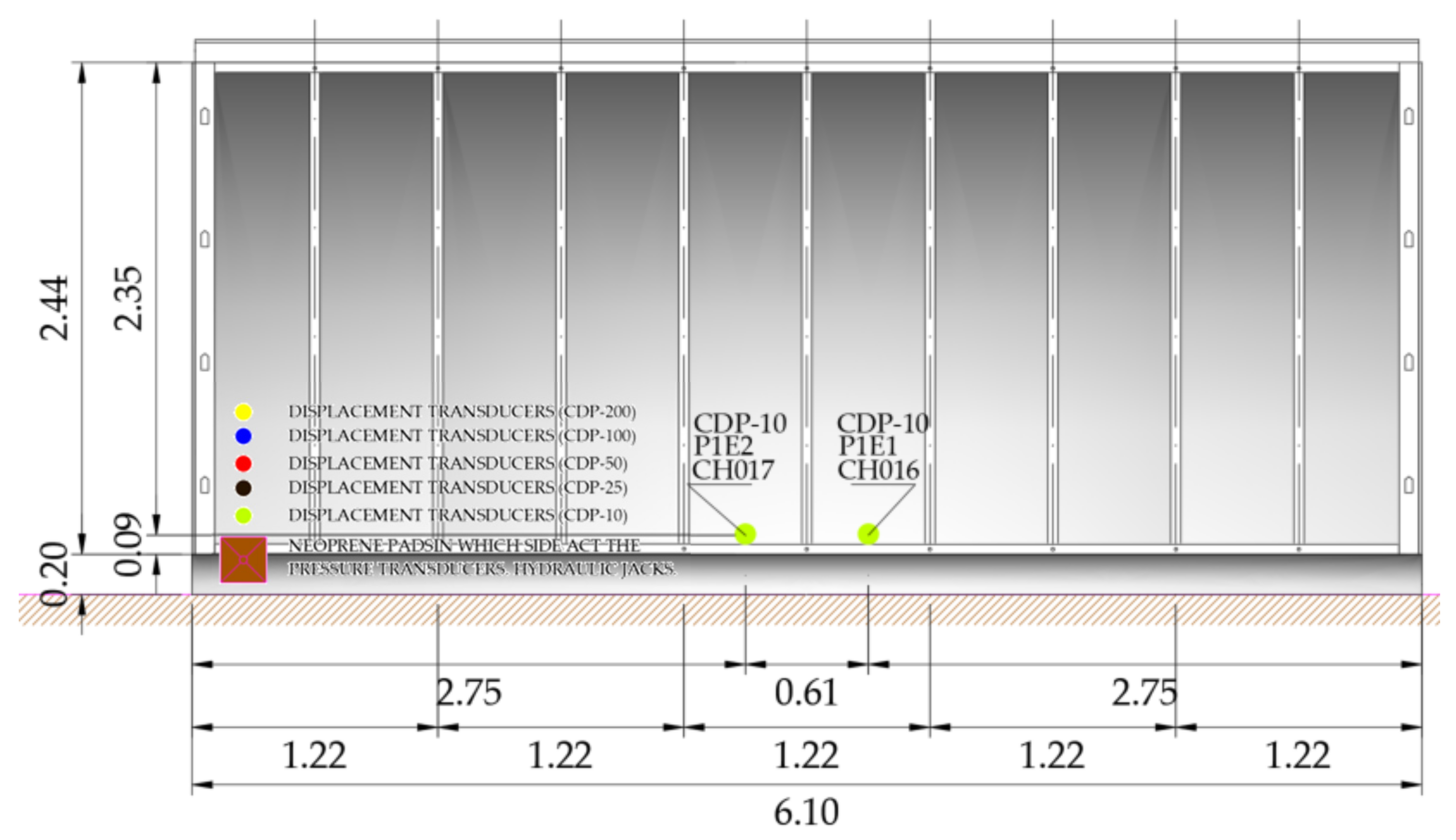
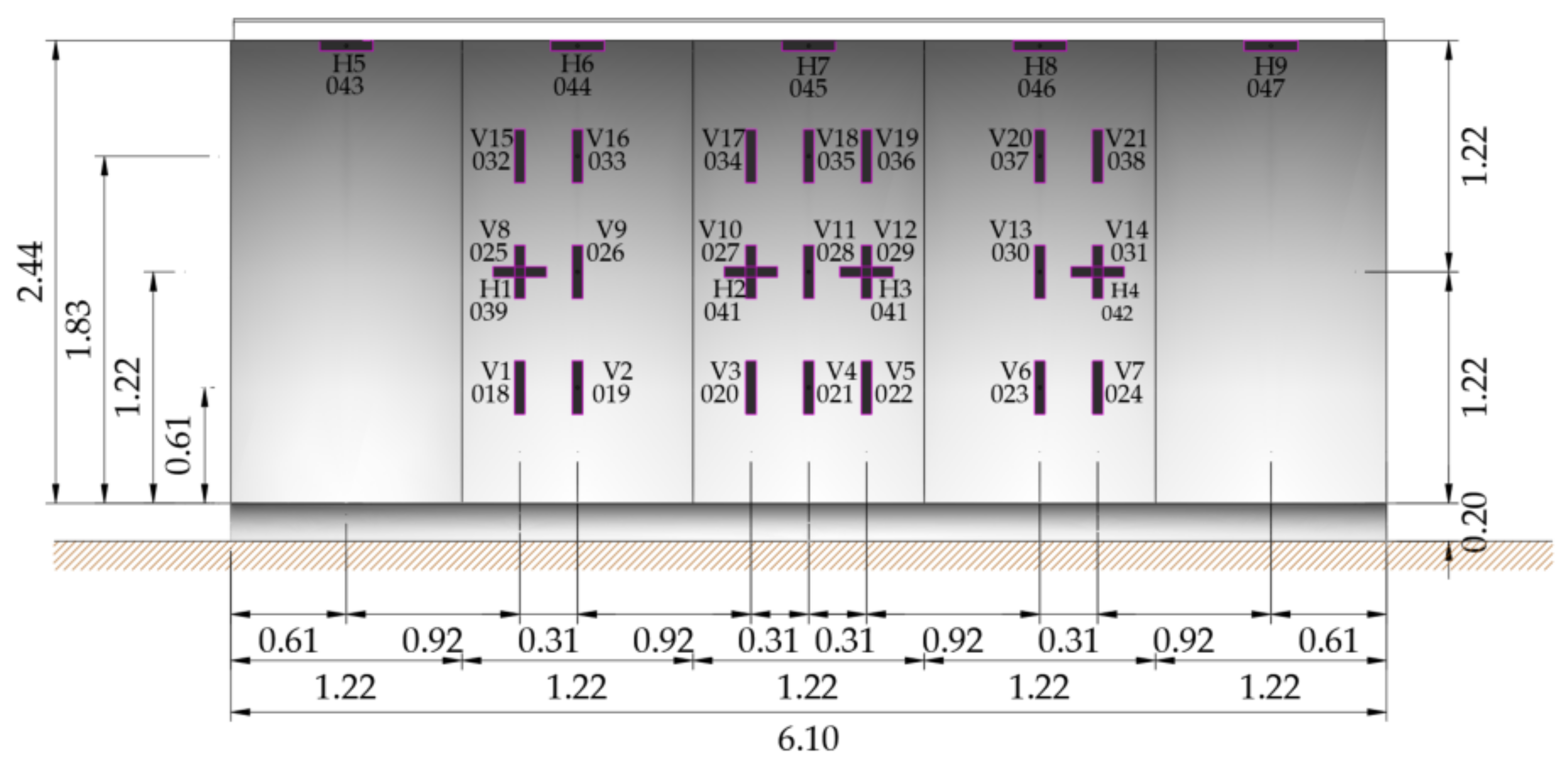
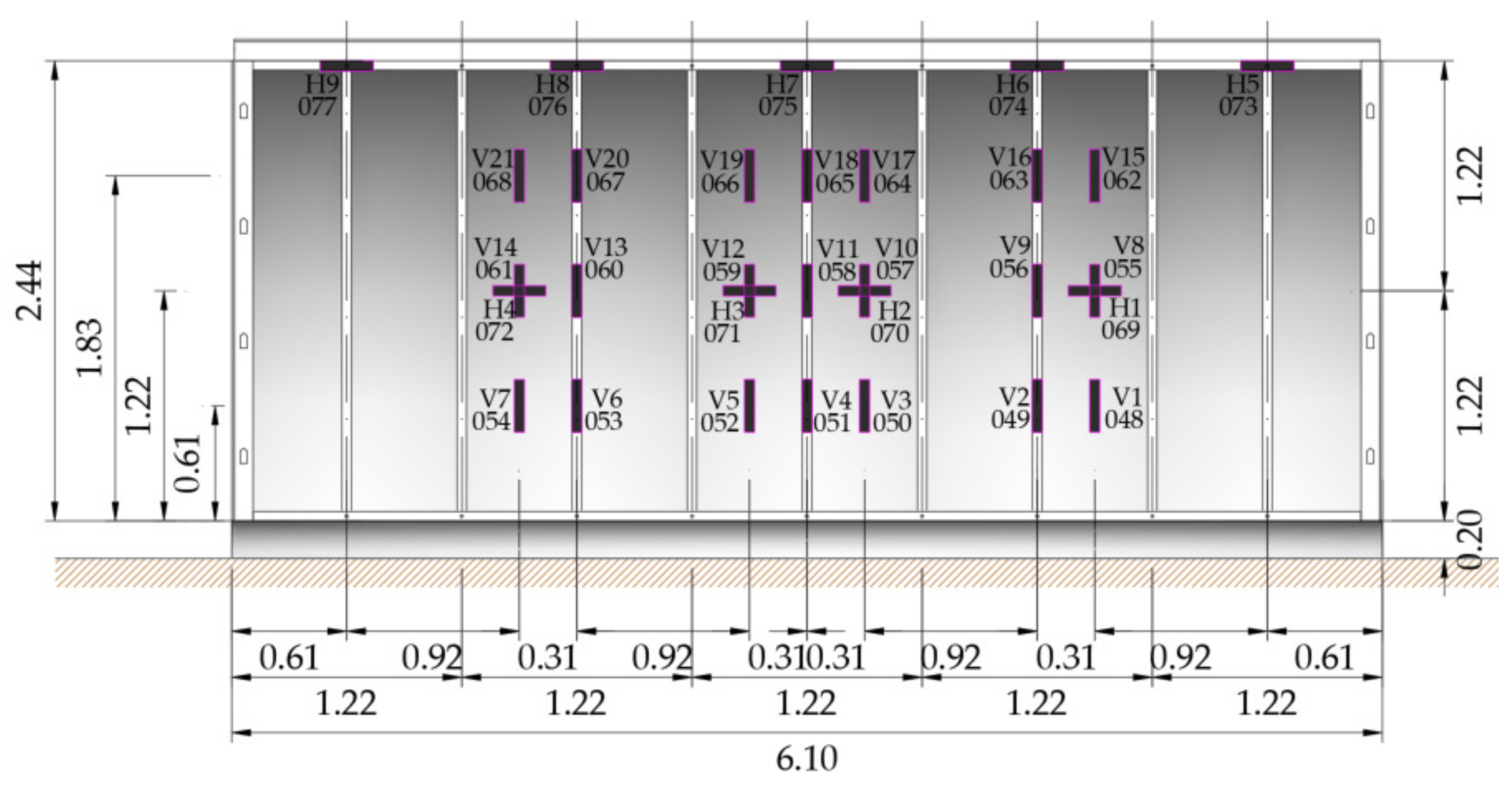
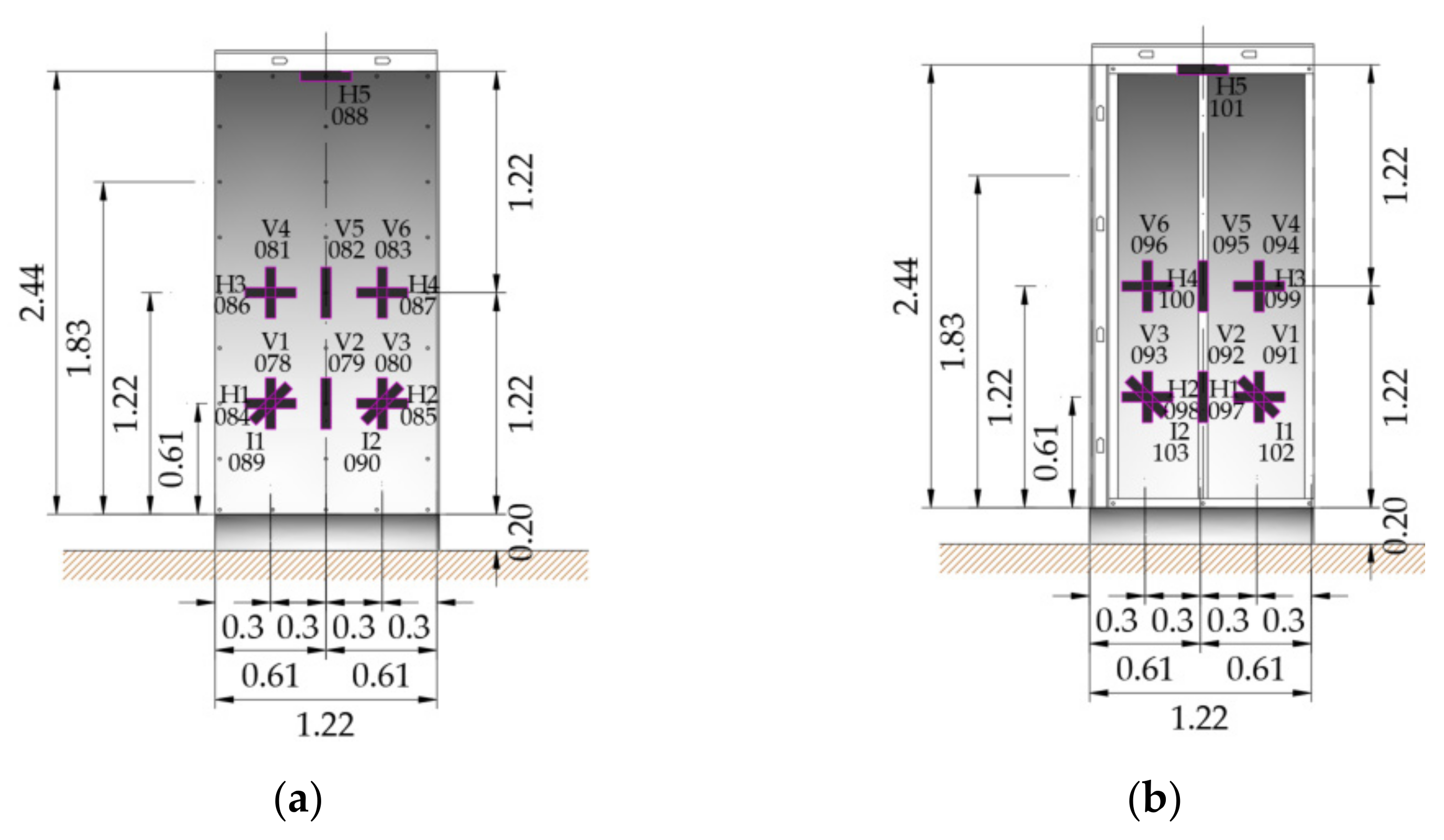
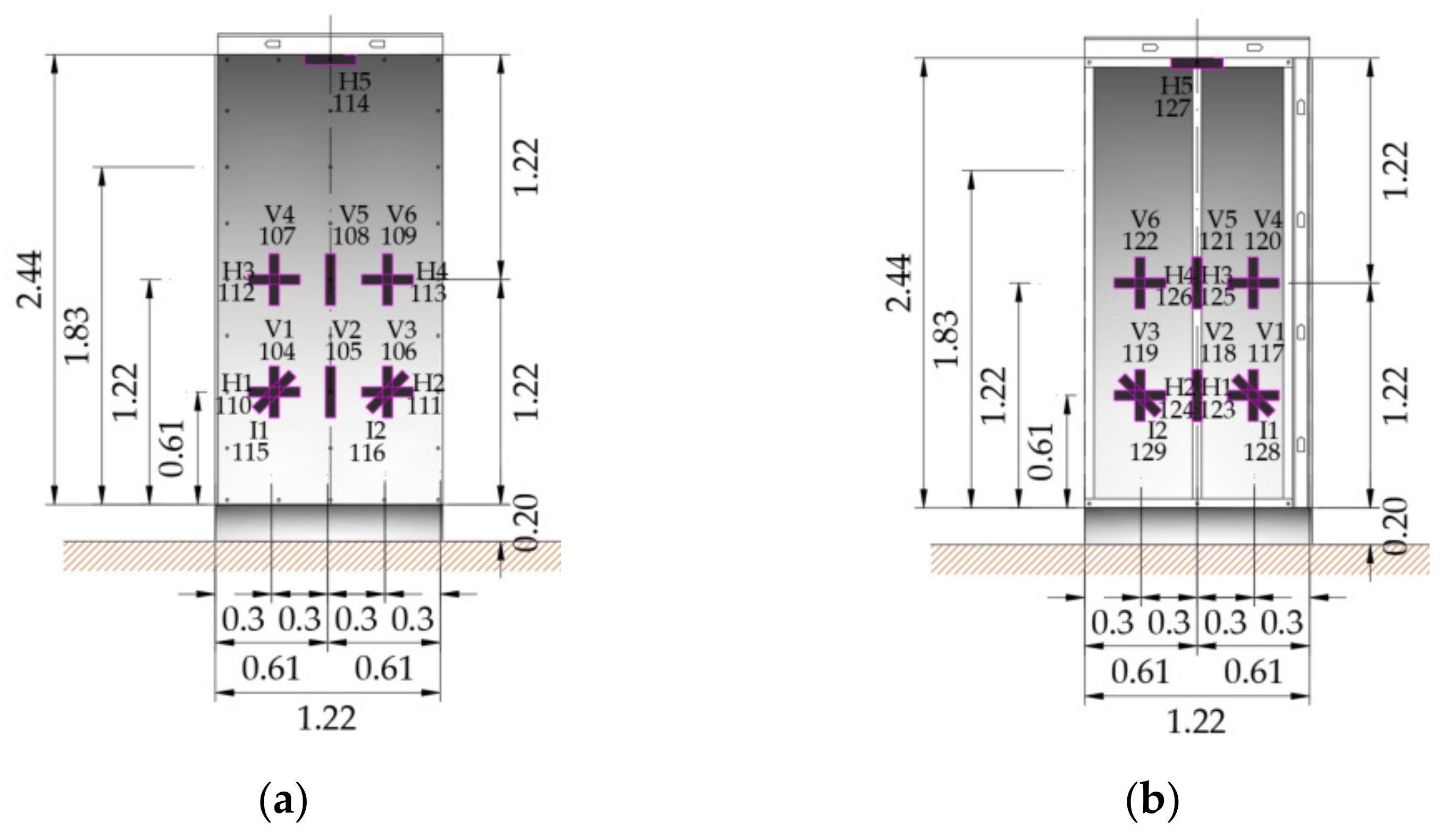
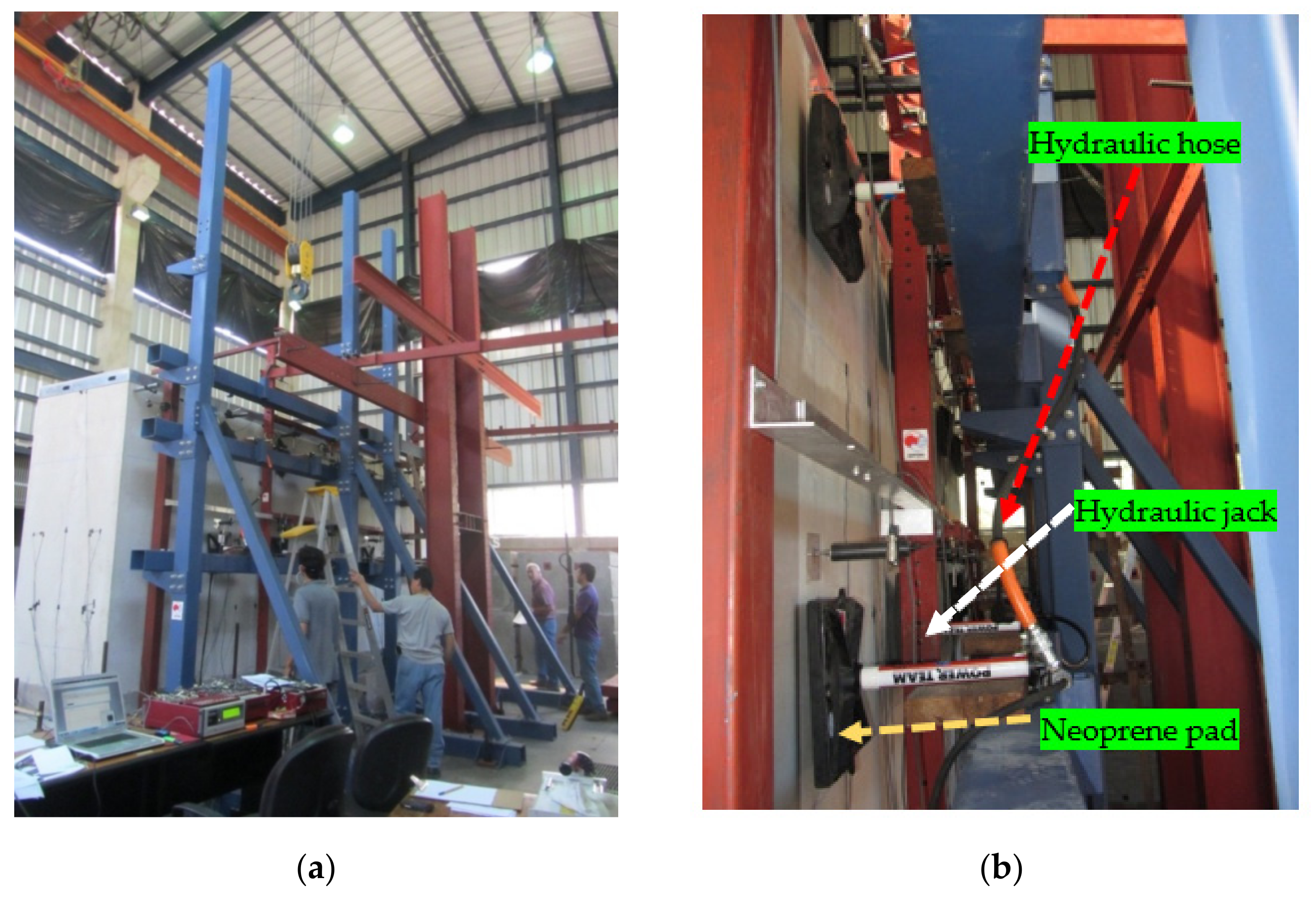
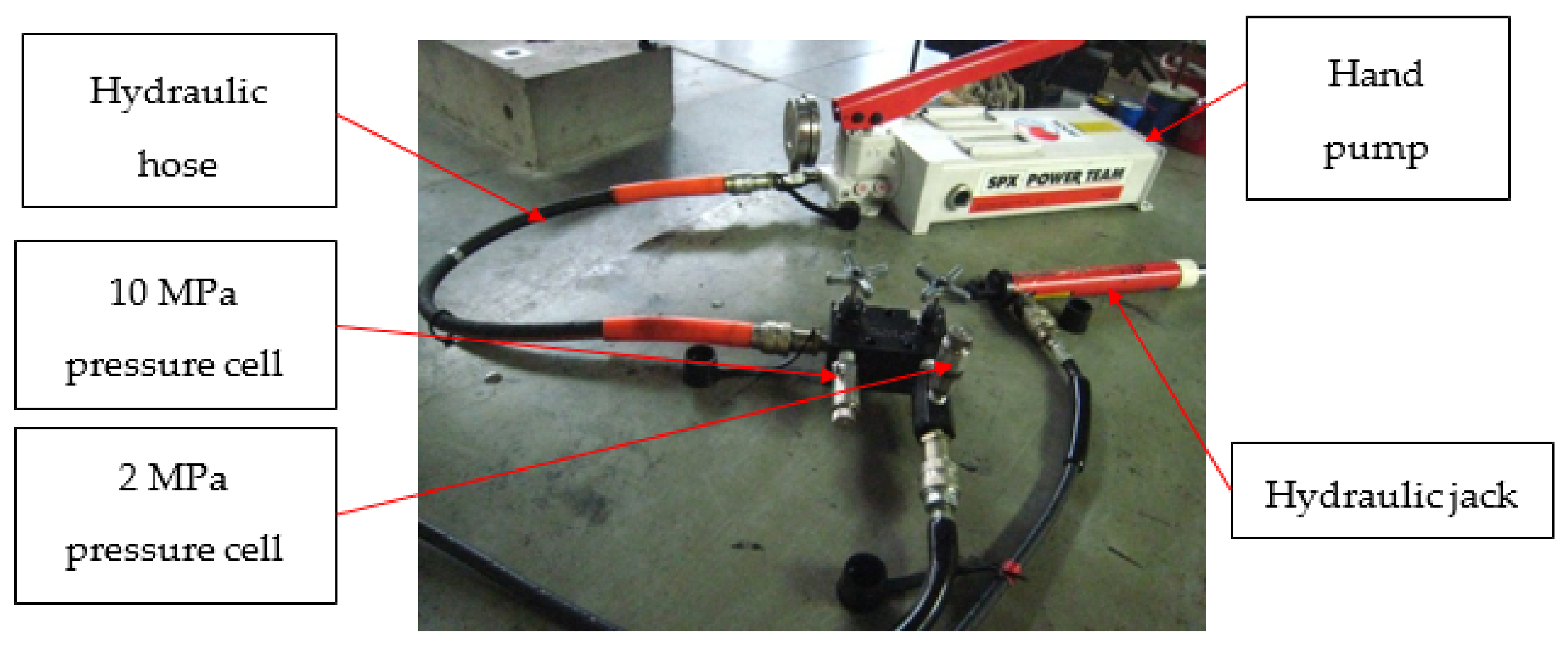
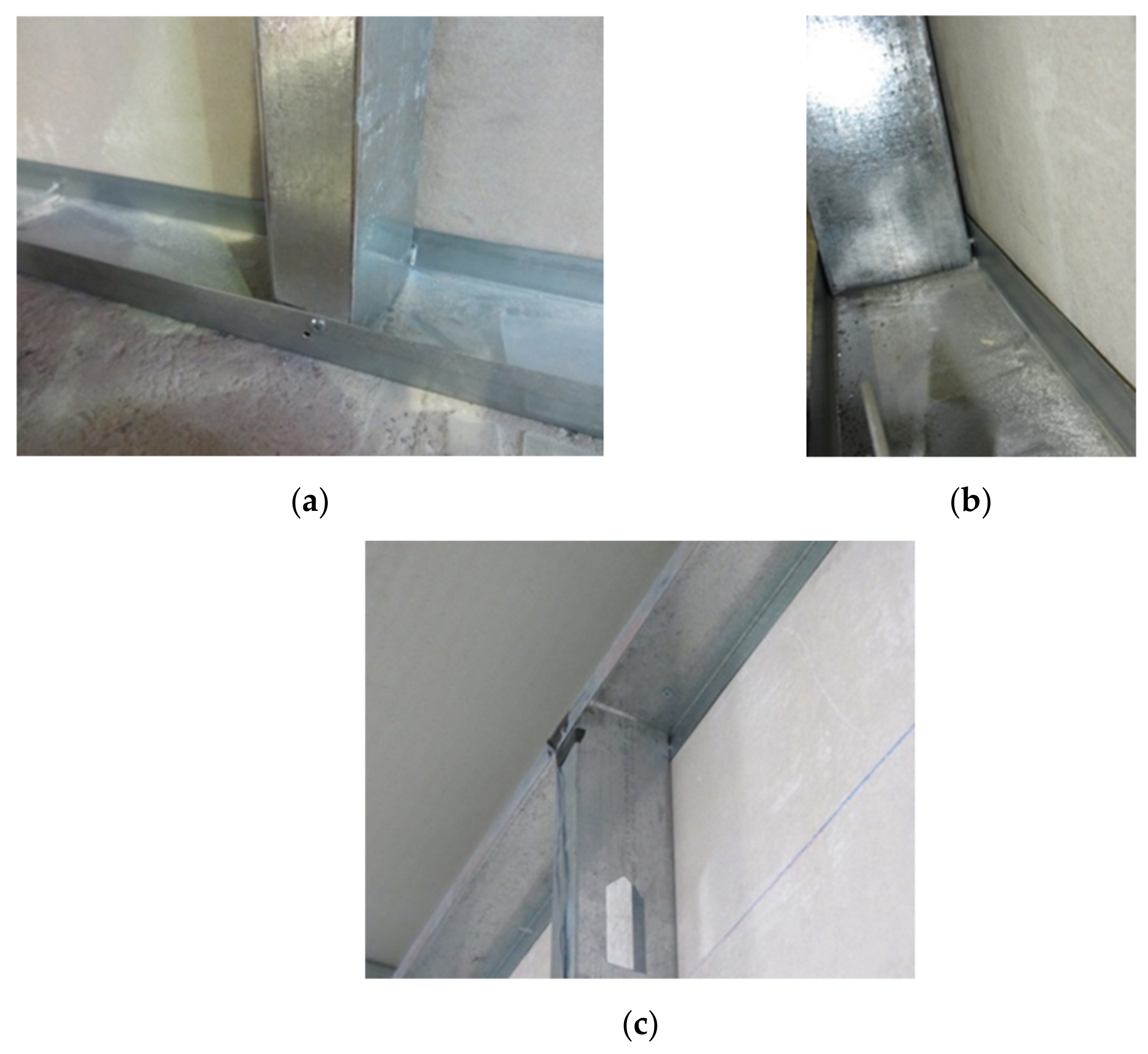
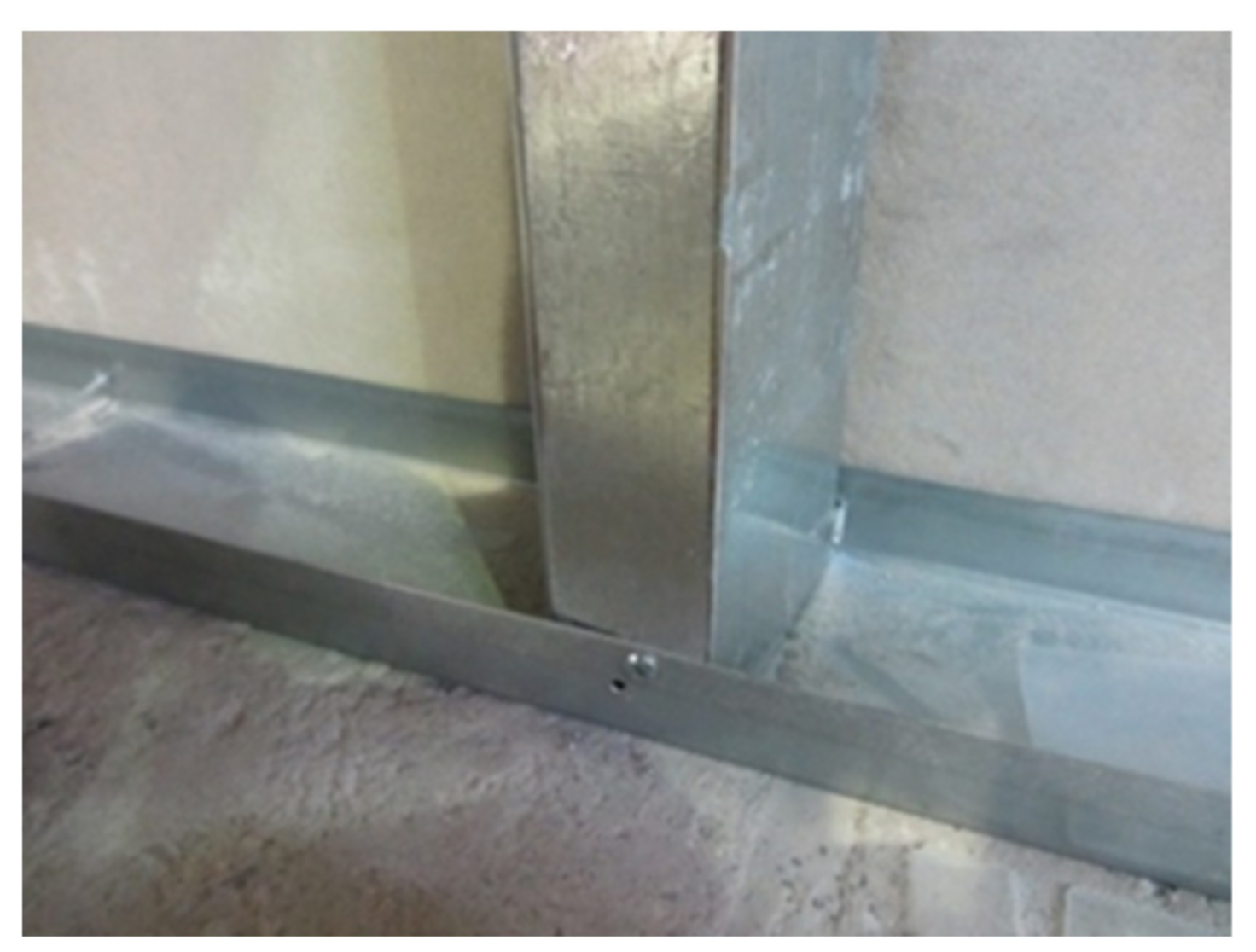
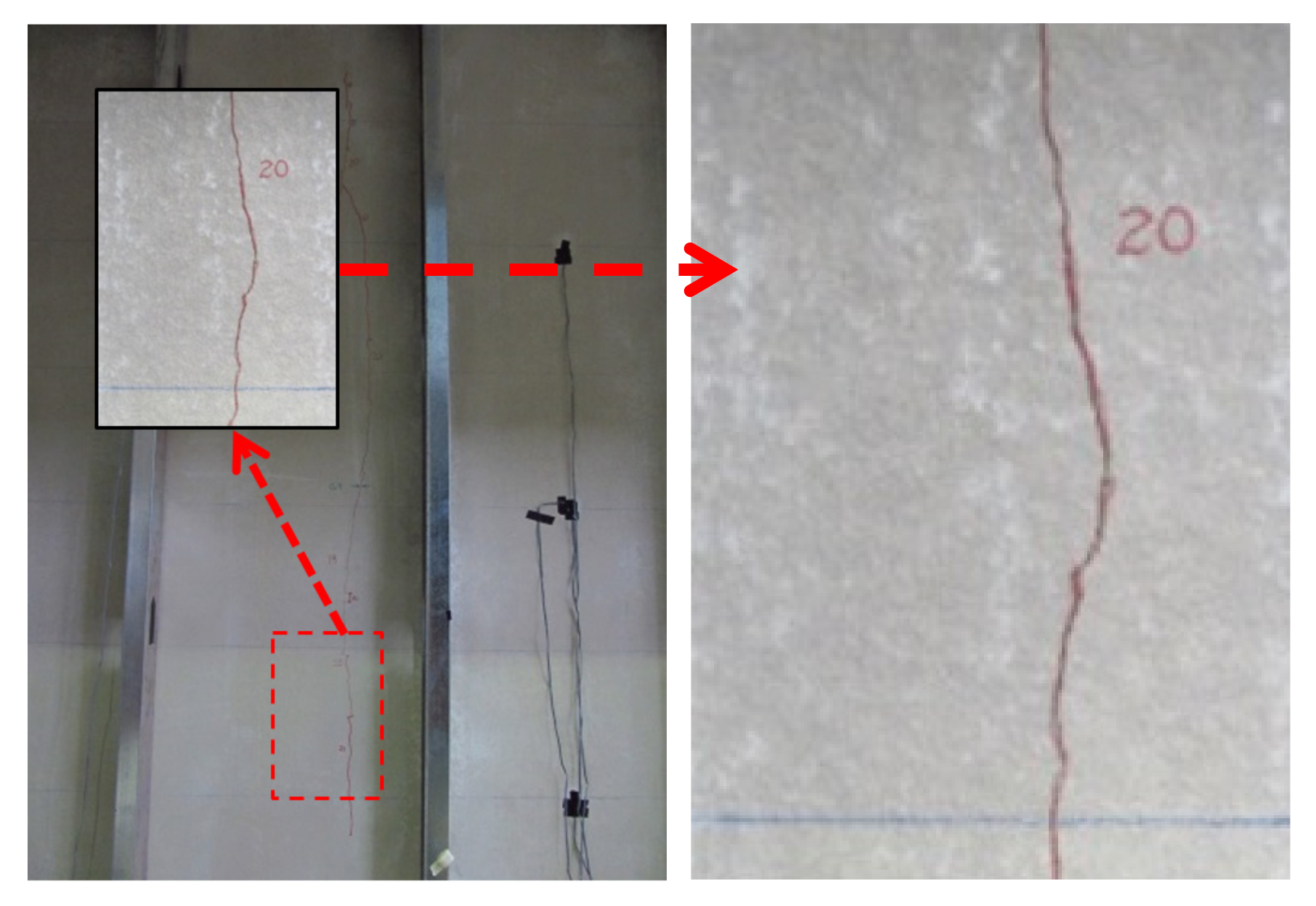
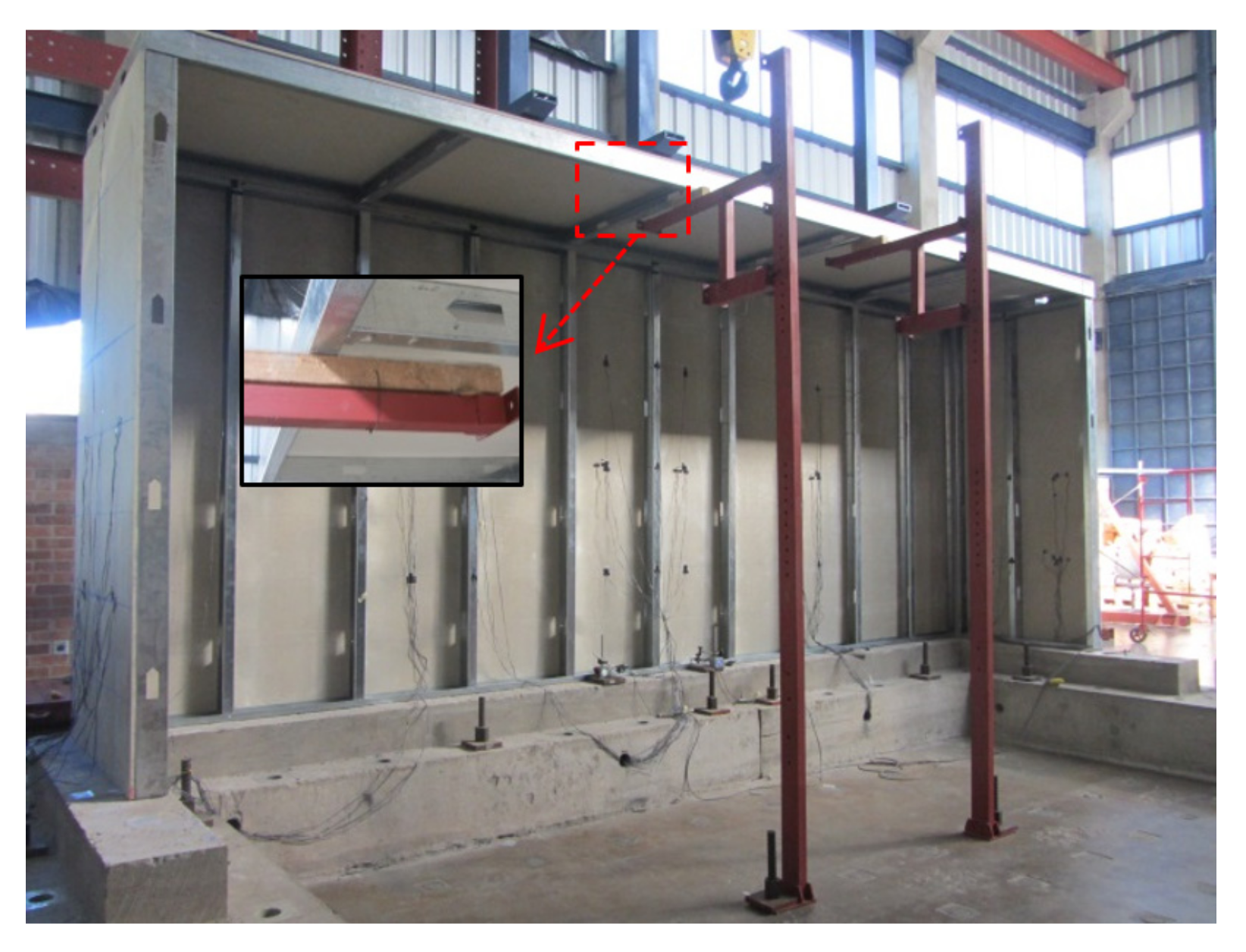
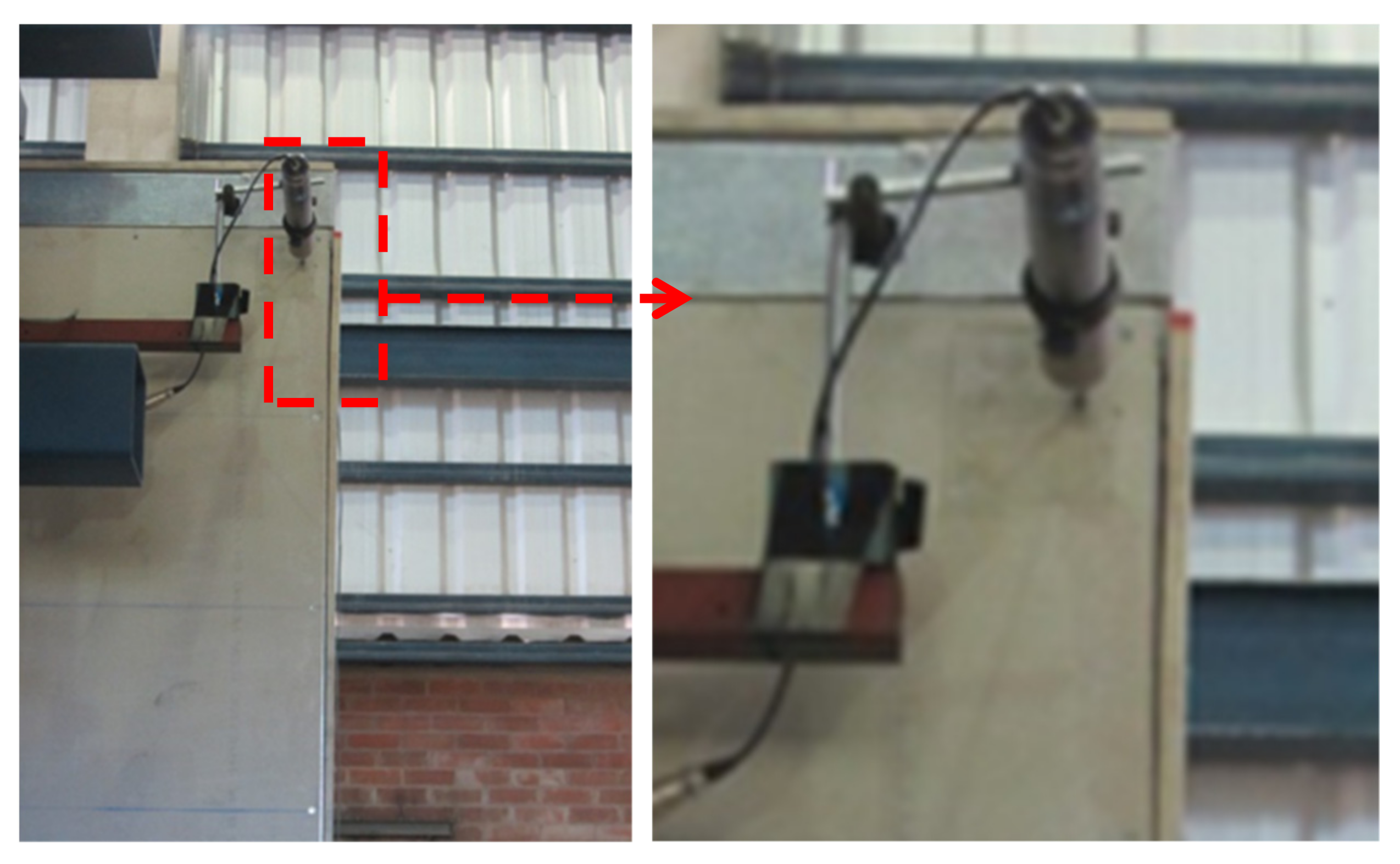
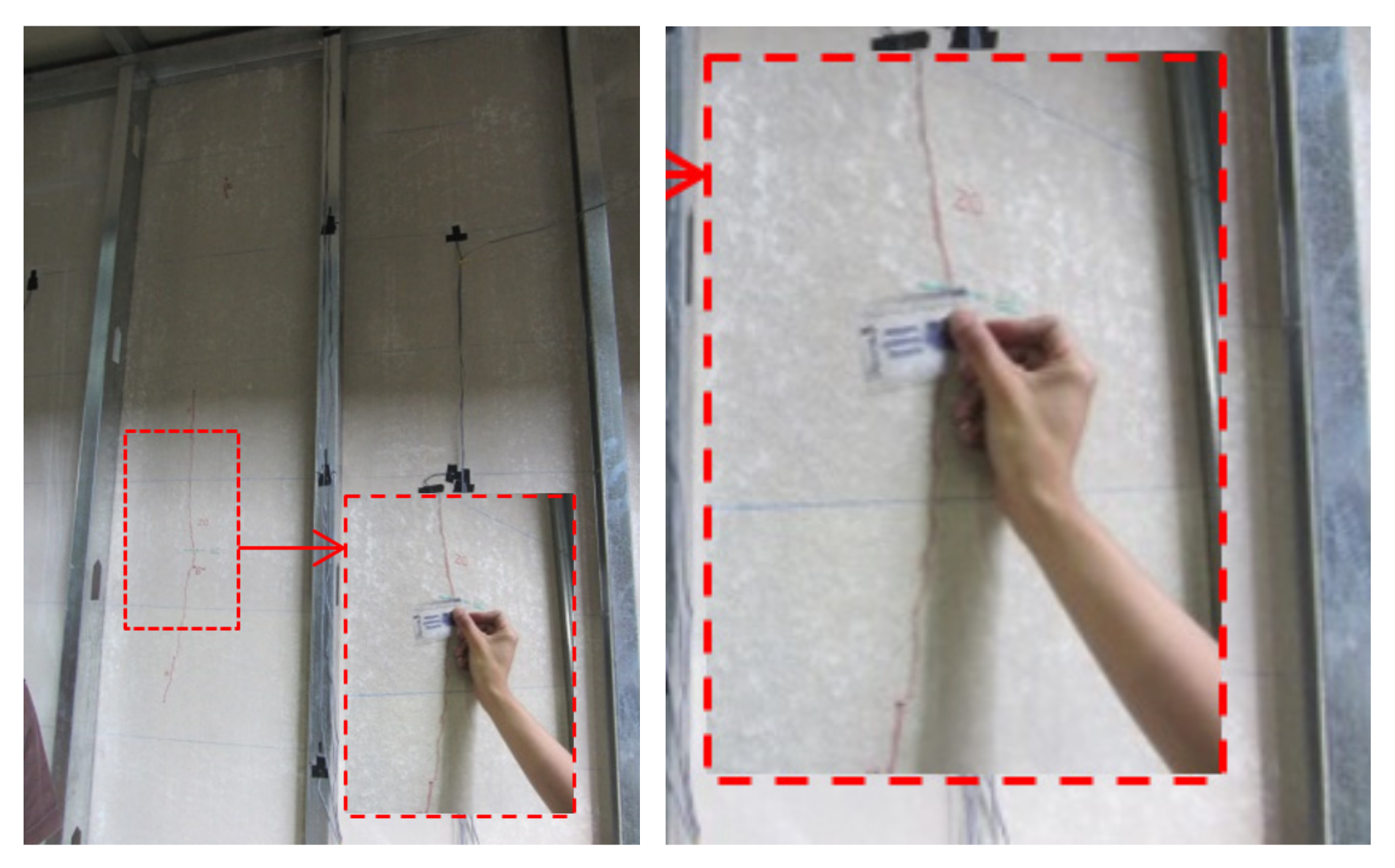
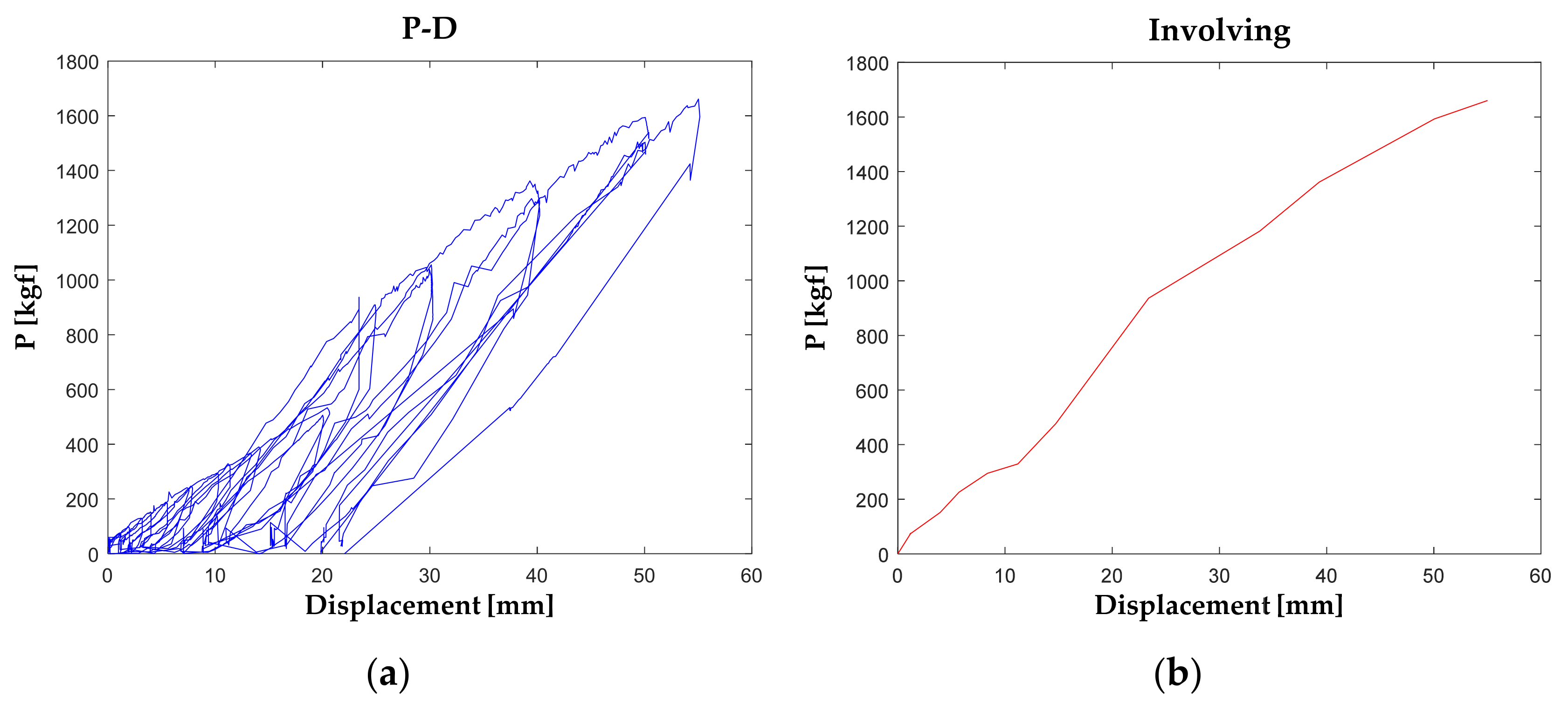
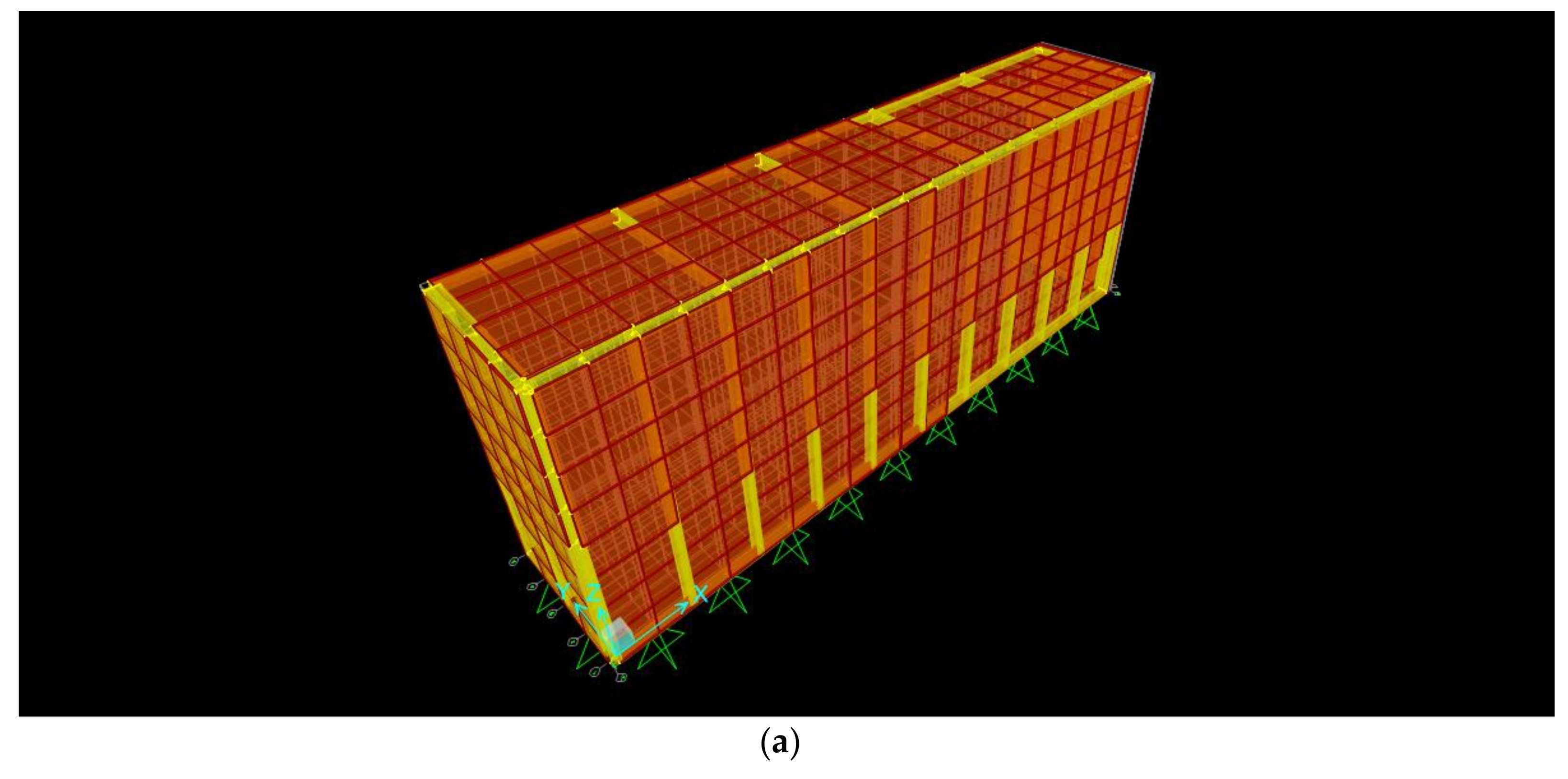
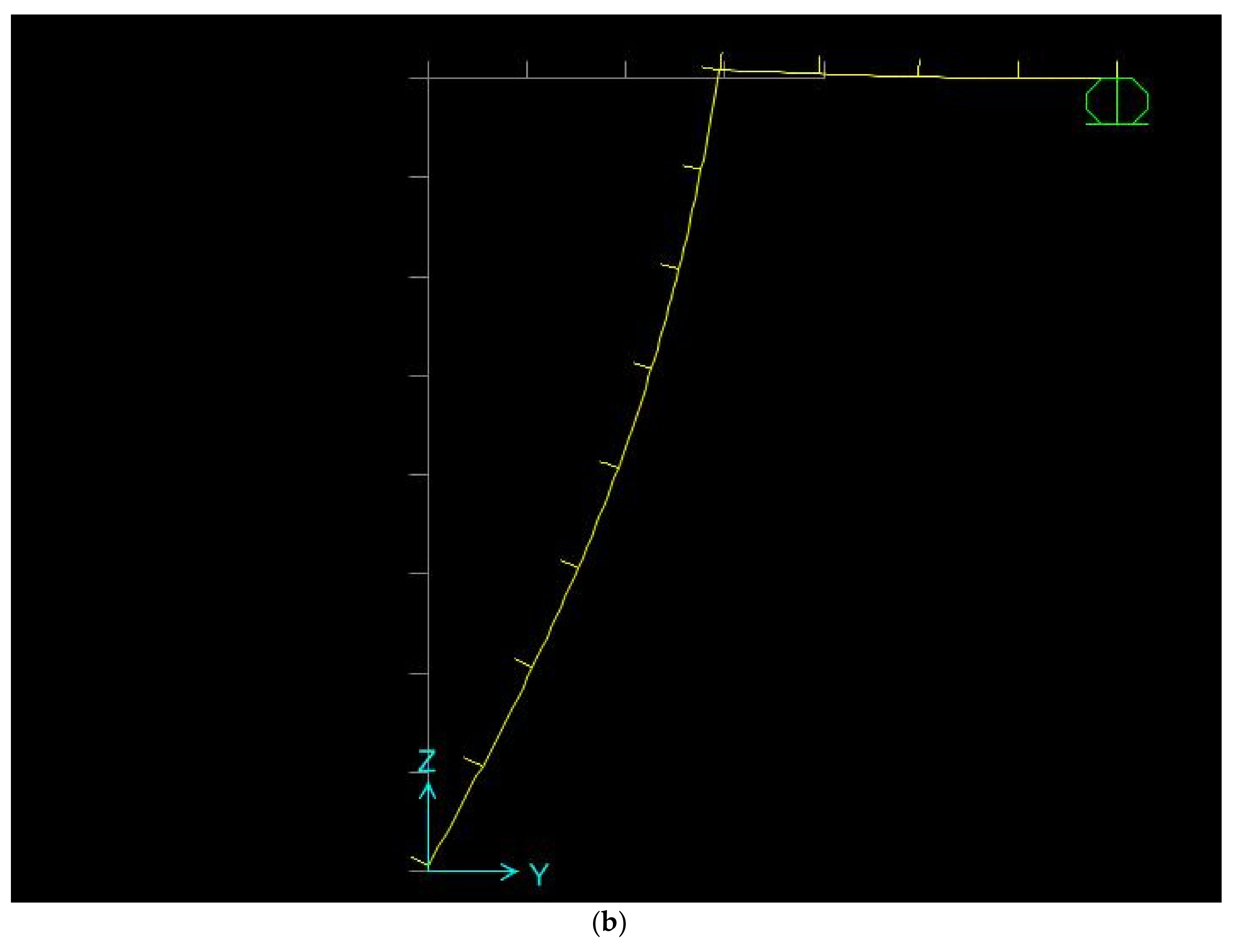
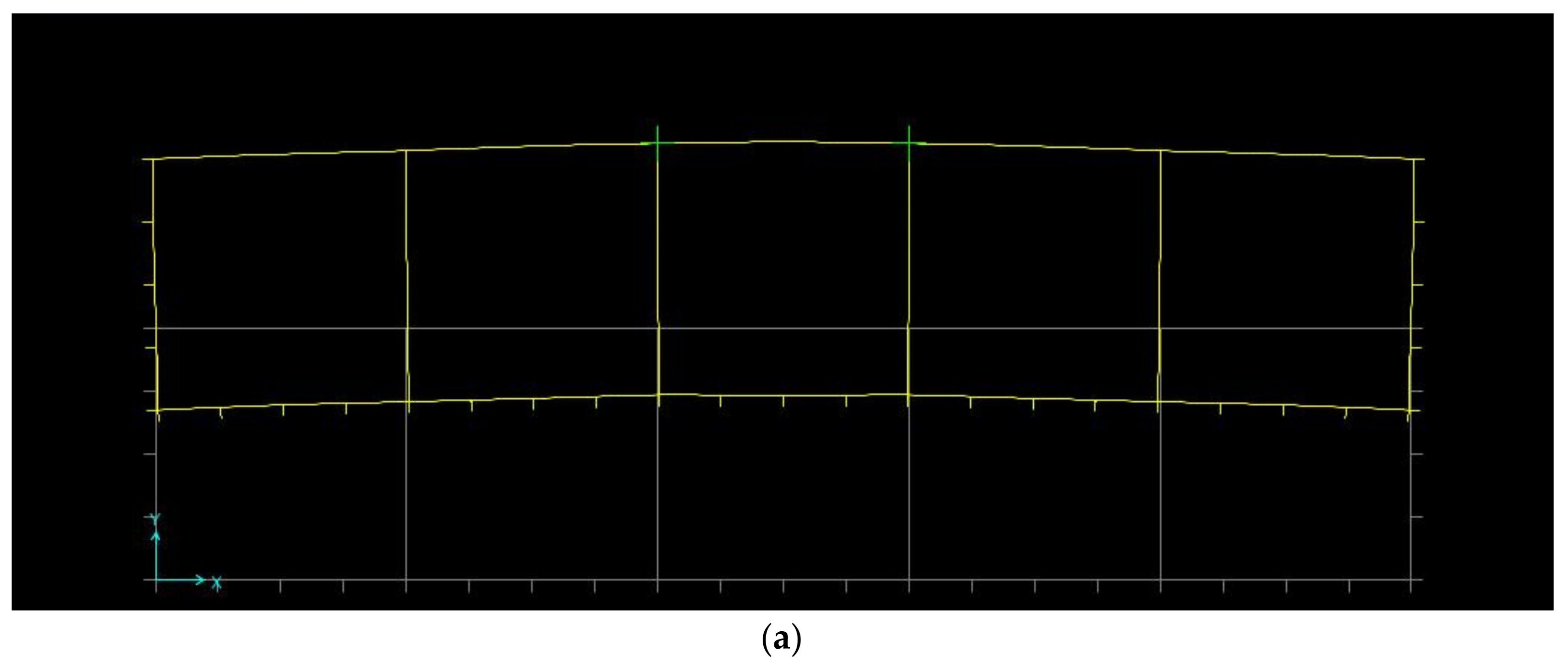
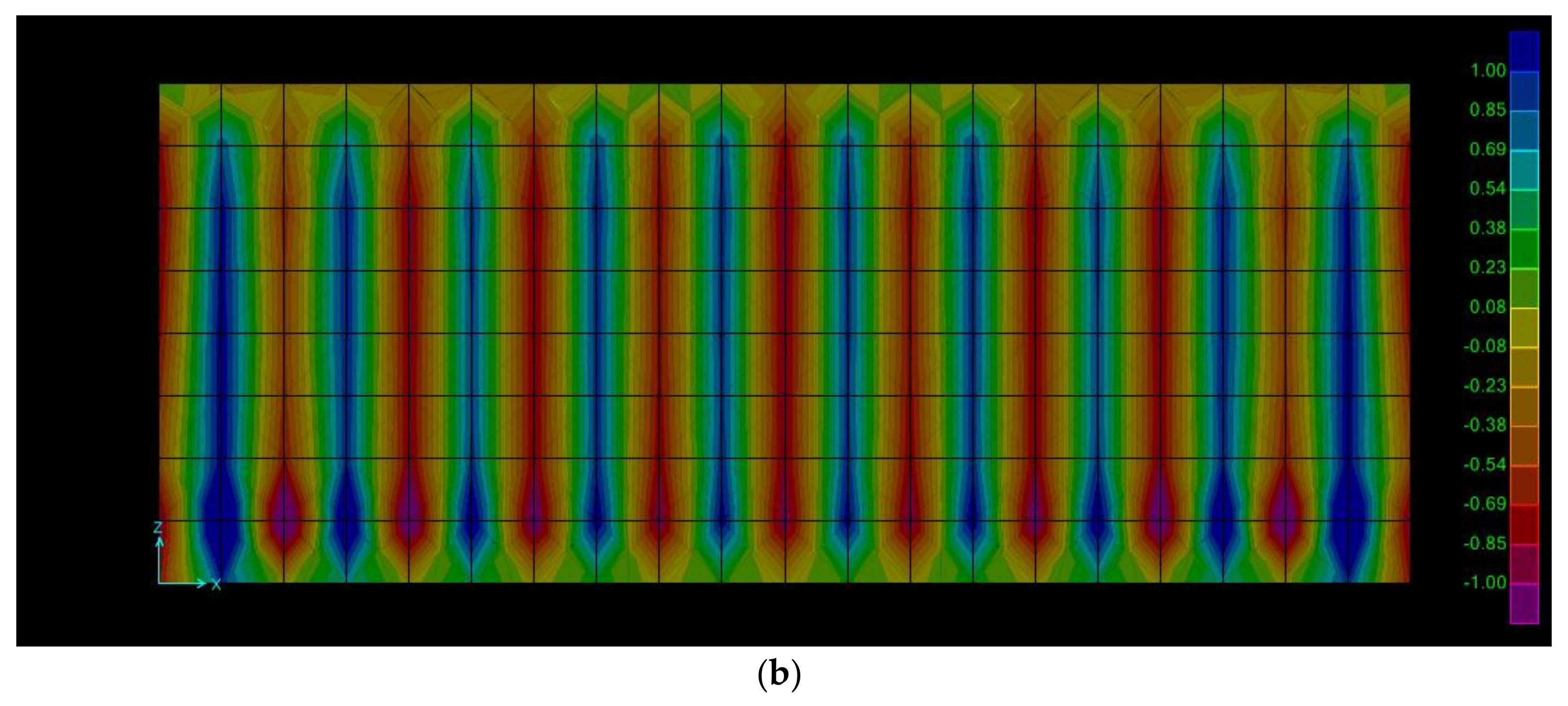

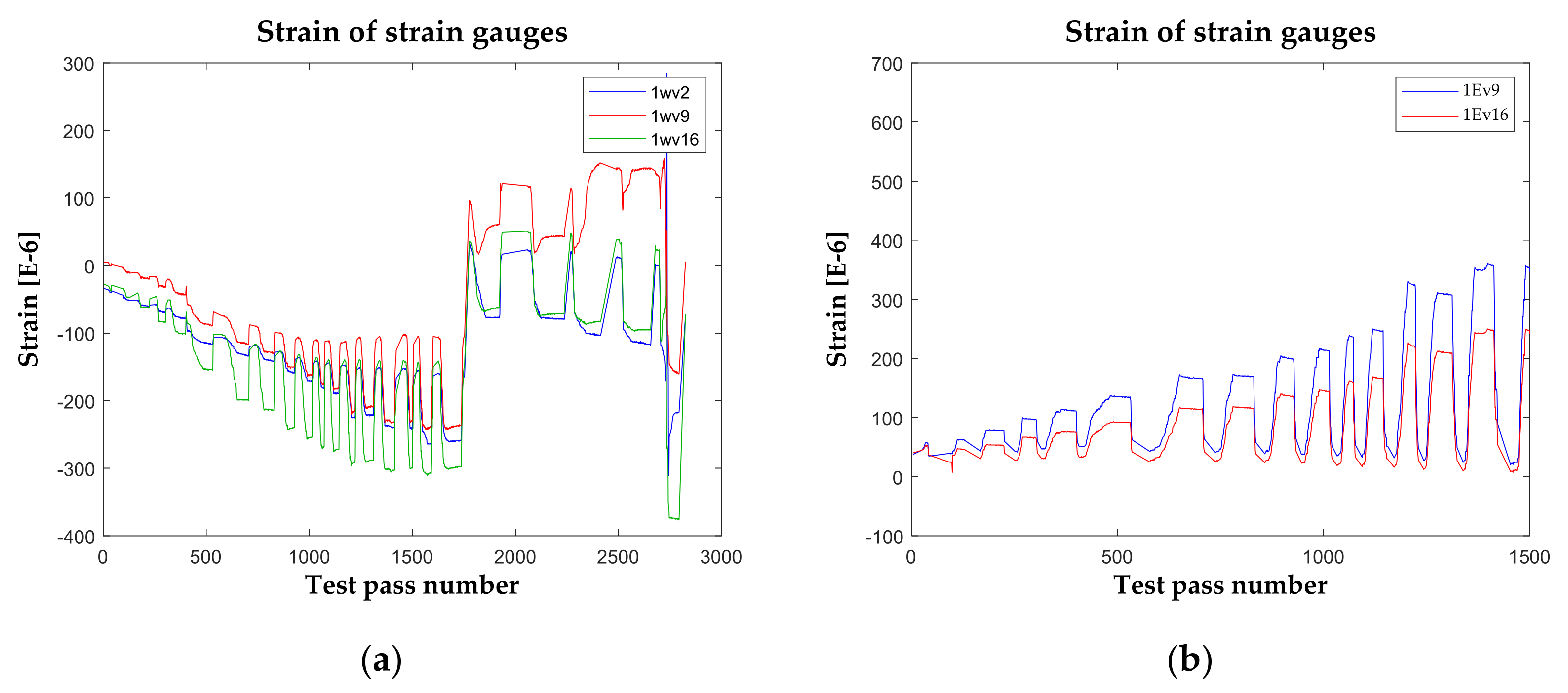
| Specimen | Yield Strength, fy (kg/cm2) | Ultimate Strength, fu (kg/cm2) | Elongation % |
|---|---|---|---|
| 1 | 3164 | 3895 | 36 |
| 2 | 3276 | 3768 | 32 |
| Cylinder | L (mm) | b (mm) | t (mm) | (kg) | (kg-cm) | I (mm4) | (kg/cm2) | (kg/cm2) |
|---|---|---|---|---|---|---|---|---|
| 1 | 312 | 27.9 | 13.6 | 10.2 | 79.7 | 5848.4 | 92.7 | 93.4 |
| 2 | 315 | 28.6 | 13.5 | 10.4 | 82.1 | 5903.1 | 94.1 |
| Cyli. | L (mm) | b (mm) | t (mm) | (kg) | (kg-cm) | I (mm4) | (kg/cm2) | (e-6) | (kg/cm2) | (kg/cm2) |
|---|---|---|---|---|---|---|---|---|---|---|
| 1 | 312 | 27.9 | 13.6 | 10.2 | 79.7 | 5848.4 | 71.9 | 1831.1 | 39,298 | 38,822 |
| 2 | 315 | 28.6 | 13.5 | 10.4 | 82.1 | 5903.1 | 75.3 | 1965.1 | 38,345 |
| Load Cycle | δni (mm) | Δni (mm) | Δoi (mm) | Poi (kg) | Δi (mm) | Pi (kg) | Notes |
|---|---|---|---|---|---|---|---|
| 1 | 1.0 | 1.0 | - | - | 1.2 | 75.7 | |
| 2 | 1.0 | 1.0 | −0.1 | 0.6 | 1.0 | 74.9 | |
| 3 | 2.0 | 2.0 | −0.1 | 0.9 | 1.9 | 99.5 | |
| 4 | 2.0 | 2.0 | 0.2 | 0.2 | 3.1 | 129.3 | |
| 5 | 4.0 | 4.0 | 0.9 | 1.9 | 3.9 | 152.3 | |
| 6 | 4.0 | 5.5 | 1.1 | −5.9 | 5.4 | 188.2 | |
| 7 | 6.0 | 7.2 | 1.2 | 2.5 | 7.4 | 240.8 | |
| 8 | 6.0 | 7.9 | 1.9 | 7.4 | 7.7 | 247.2 | |
| 9 | 8.0 | 9.9 | 1.9 | 5.9 | 8.3 | 295.0 | Retired CDP 10 |
| 10 | 8.0 | 11.0 | 2.9 | 25.5 | 11.2 | 329.0 | Dimensions with CDP 25 |
| 11 | 10.0 | 13.3 | 3.2 | 23.2 | 13.3 | 367.9 | |
| 12 | 10.0 | 14.0 | 3.9 | 6.2 | 14.1 | 390.3 | |
| 13 | 20.0 | 20.0 | 4.4 | 5.2 | 20.4 | 533.0 | |
| 14 | 20.0 | 20.0 | 6.8 | 8.8 | 19.9 | 505.9 | |
| 15 | 25.0 | 25.0 | 7.0 | 0.1 | 23.4 | 609.3 | Retired CDP 25 |
| 16 | 25.0 | 25.0 | 8.8 | 16.3 | 24.8 | 908.0 | Dimensions with CDP 200 |
| 17 | 30.0 | 30.0 | 9.1 | 30.1 | 30.1 | 1054.7 | |
| 18 | 30.0 | 30.0 | 11.3 | 31.6 | 29.9 | 1037.9 | |
| 19 | 40.0 | 40.0 | 9.4 | 41.8 | 39.3 | 1361.2 | |
| 20 | 40.0 | 40.0 | 15.4 | 22.4 | 40.1 | 1292.4 | |
| 21 | 50.0 | 50.0 | 16.5 | 27.5 | 50.1 | 1592.8 | |
| 22 | 50.0 | 50.0 | 19.9 | 0.0 | 50.0 | 1502.5 | |
| 23 | 60.0 | 60.0 | 21.7 | 29.0 | 55.0 | 1660.1 | Sheathing failure |
| Load Cycle | Δoi (mm) | Poi (kg) | Δi (mm) | Pi (kg) | Ki (kg/cm) | CDP | Ki Average (kg/cm) |
|---|---|---|---|---|---|---|---|
| 1 | - | - | 1.2 | 75.7 | 631 | 10 | 493 |
| 2 | −0.1 | 0.6 | 1.0 | 74.9 | 658 | 10 | |
| 3 | −0.1 | 0.9 | 1.9 | 99.5 | 494 | 10 | |
| 4 | 0.2 | 0.2 | 3.1 | 129.3 | 448 | 10 | |
| 5 | 0.9 | 1.9 | 3.9 | 152.3 | 507 | 10 | |
| 6 | 1.1 | −5.9 | 5.4 | 188.2 | 454 | 10 | |
| 7 | 1.2 | 2.5 | 7.4 | 240.8 | 384 | 10 | |
| 8 | 1.9 | 7.4 | 7.7 | 247.2 | 408 | 10 | |
| 9 | 1.9 | 5.9 | 8.3 | 295.0 | 452 | 10 | |
| 10 | 2.9 | 25.5 | 11.2 | 329.0 | 369 | 25 | 362 |
| 11 | 3.2 | 23.2 | 13.3 | 367.9 | 344 | 25 | |
| 12 | 3.9 | 6.2 | 14.1 | 390.3 | 379 | 25 | |
| 13 | 4.4 | 5.2 | 20.4 | 533.0 | 330 | 25 | |
| 14 | 6.8 | 8.8 | 19.9 | 505.9 | 376 | 25 | |
| 15 | 7.0 | 0.1 | 23.4 | 609.3 | 373 | 25 | |
| 16 | 8.8 | 16.3 | 24.8 | 908.0 | 557 | 200 | 499 |
| 17 | 9.1 | 30.1 | 30.1 | 1054.7 | 486 | 200 | |
| 18 | 11.3 | 31.6 | 29.9 | 1037.9 | 538 | 200 | |
| 19 | 9.4 | 41.8 | 39.3 | 1361.2 | 441 | 200 | |
| 20 | 15.4 | 22.4 | 40.1 | 1292.4 | 513 | 200 | |
| 21 | 16.5 | 27.5 | 50.1 | 1592.8 | 467 | 200 | |
| 22 | 19.9 | 0.0 | 50.0 | 1502.5 | 498 | 200 | |
| 23 | 21.7 | 29.0 | 55.0 | 1660.1 | 490 | 200 | |
| 461 |
| Specimen | Detail | Stiffness (kg/cm) |
|---|---|---|
| Experimental specimen | Average of the stiffness values obtained on the different load phases | 461 |
| Numerical specimen | Higher elasticity unit specified by the manufacturer E = 40,816 kg/cm2 | 692 |
| Lower elasticity unit specified by the manufacturer E = 25,510 kg/cm2 | 578 | |
| Average elasticity unit specified by the manufacturer E = 33,163 kg/cm2 | 637 | |
| Elasticity unit obtained on the experimental program E = 38,822 kg/cm2 | 678 |
Publisher’s Note: MDPI stays neutral with regard to jurisdictional claims in published maps and institutional affiliations. |
© 2021 by the authors. Licensee MDPI, Basel, Switzerland. This article is an open access article distributed under the terms and conditions of the Creative Commons Attribution (CC BY) license (https://creativecommons.org/licenses/by/4.0/).
Share and Cite
Moreno Cobo, M.; Carazo Alvarez, J.D.; Méndez de Hasbun, P.; Hasbun Hasbun, J.C.; Amador, A.M.G.; Jiménez de Cisneros, J.J. Experimental Behavior of a Full-Scale Housing Section Built with Cold-Formed Steel Shear Wall Panels under Horizontal Monotonic and Cyclic Loading. Appl. Sci. 2021, 11, 10934. https://doi.org/10.3390/app112210934
Moreno Cobo M, Carazo Alvarez JD, Méndez de Hasbun P, Hasbun Hasbun JC, Amador AMG, Jiménez de Cisneros JJ. Experimental Behavior of a Full-Scale Housing Section Built with Cold-Formed Steel Shear Wall Panels under Horizontal Monotonic and Cyclic Loading. Applied Sciences. 2021; 11(22):10934. https://doi.org/10.3390/app112210934
Chicago/Turabian StyleMoreno Cobo, Matilde, Juan D. Carazo Alvarez, Patricia Méndez de Hasbun, José Carlos Hasbun Hasbun, Ana María Gómez Amador, and Juan José Jiménez de Cisneros. 2021. "Experimental Behavior of a Full-Scale Housing Section Built with Cold-Formed Steel Shear Wall Panels under Horizontal Monotonic and Cyclic Loading" Applied Sciences 11, no. 22: 10934. https://doi.org/10.3390/app112210934
APA StyleMoreno Cobo, M., Carazo Alvarez, J. D., Méndez de Hasbun, P., Hasbun Hasbun, J. C., Amador, A. M. G., & Jiménez de Cisneros, J. J. (2021). Experimental Behavior of a Full-Scale Housing Section Built with Cold-Formed Steel Shear Wall Panels under Horizontal Monotonic and Cyclic Loading. Applied Sciences, 11(22), 10934. https://doi.org/10.3390/app112210934







